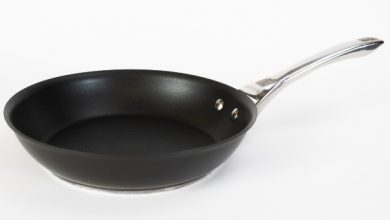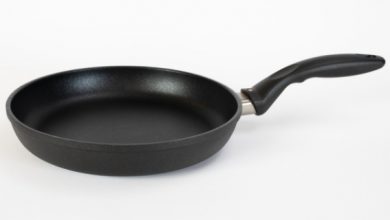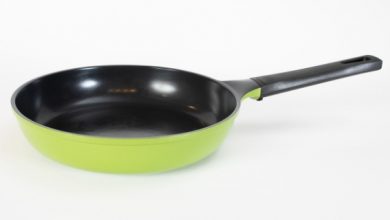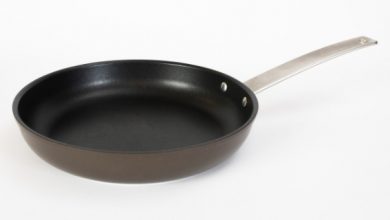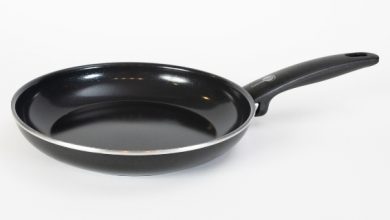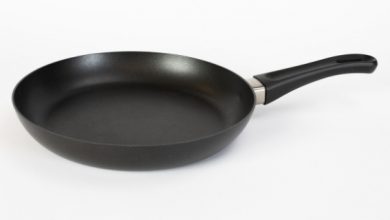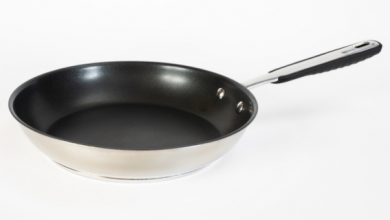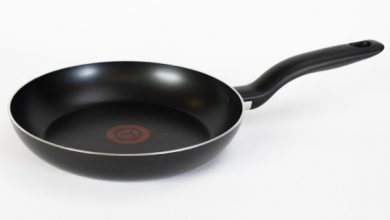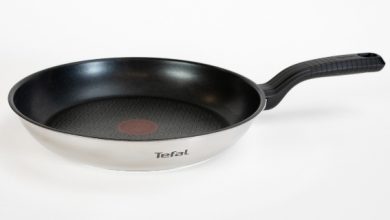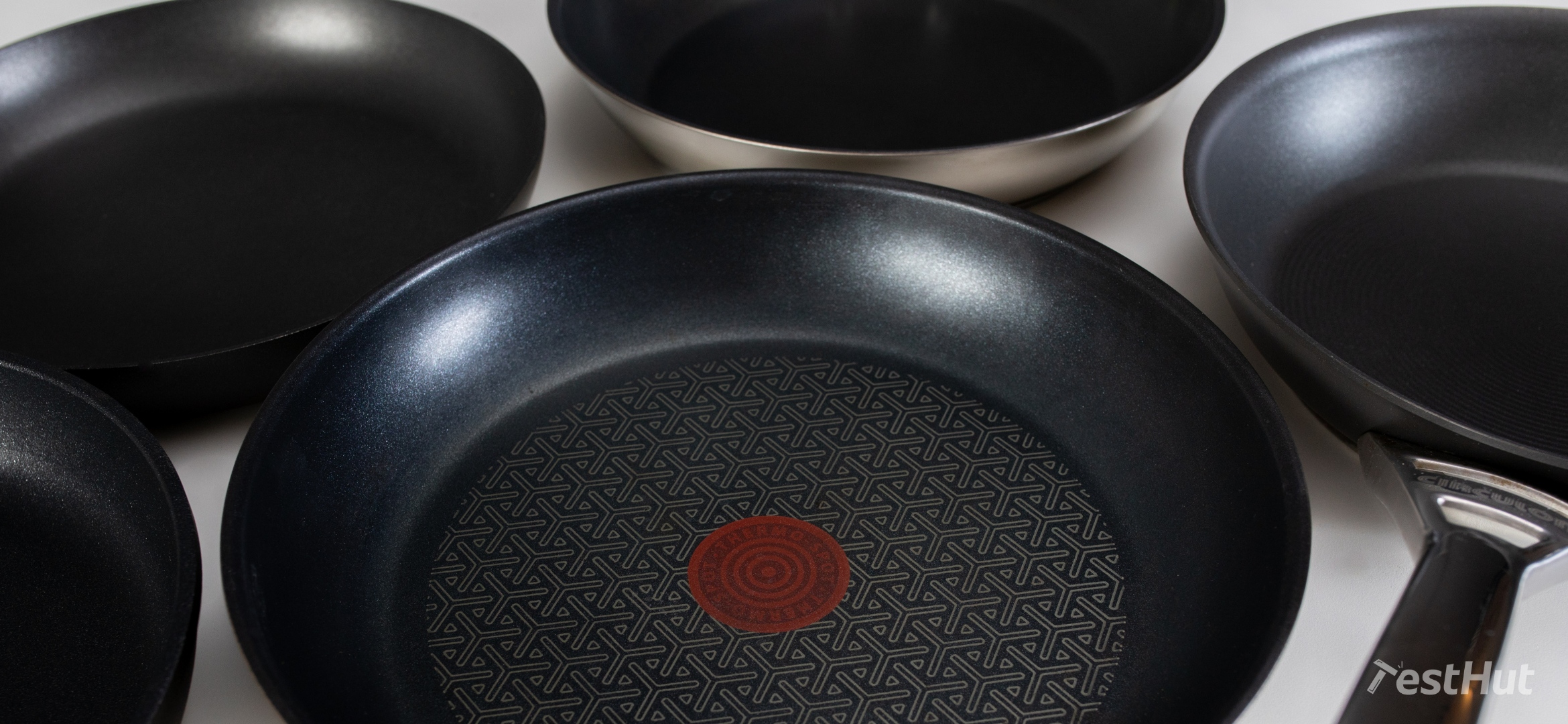
Best Nonstick Frying Pan
A great nonstick pan is a kitchen essential. We love nonstick pans because they are easy to use, but picking the best option can be challenging. There are thousands of nonstick pans available on the market. We researched over 400 different models, analysed both user and professional reviews. Then we handpicked 11 of the best nonstick frying pans and performed two months of rigorous testing to find one that is right for you.
TestHut’s Top Choice: Circulon Infinite French Skillet 24cm
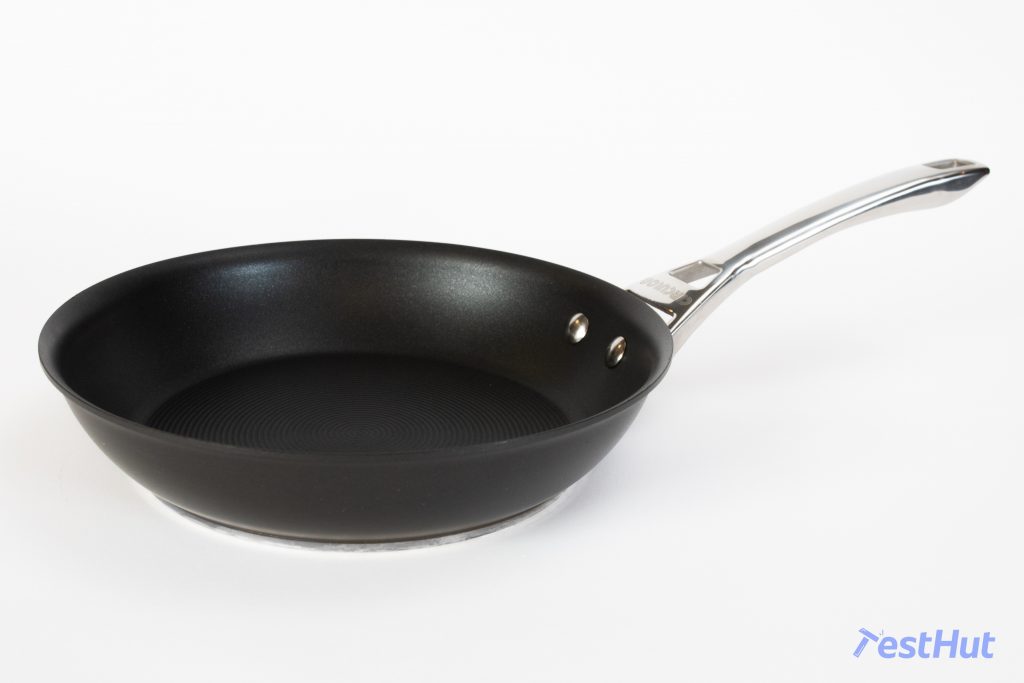
Pros
- Perfect size and shape
- Incredible nonstick surface
- Even heating all around
- Well-balanced
- Durable coating and construction
Cons
- Handle is a bit long and gets warm
- Takes 4 minutes to heat up
- A bit pricey for nonstick
- Not the best looking pan in our test
Without a doubt, the Circulon Infinite French Skillet is TestHut’s Best Value nonstick pan. It earned high scores in almost every test, and no matter what we decided to cook, the Circulon made great dishes.
In all food release tests, it was as good as our Premium Pick, the Swiss Diamond XD frying pan. Even after months of testing, the Circulon’s nonstick surface remained pristine.
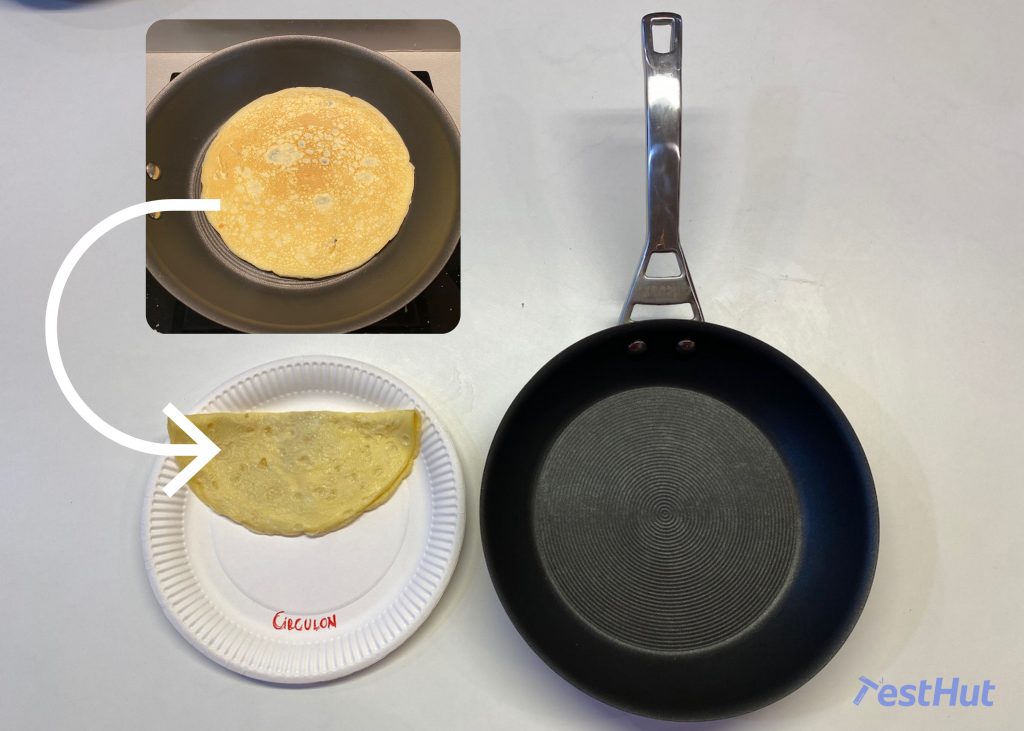
The Circulon cooks very evenly, and thanks to the anodized aluminum body with the thick bottom disc, it holds heat and stays steady on any hob.
One thing we enjoyed the most about the Circulon nonstick pan is its shape. All the team members agreed that this is the ultimate form for an everyday frying pan. Flared sides allow easy utensil access, food flipping, and overall, promote liquid evaporation. It is great for searing foods and deep enough for stir fries.
The Circulon nonstick pan is easy to use. It is well balanced and weighs 1.1 kg, and its curved rim and an incredible nonstick surface made the pouring process clean and easy.
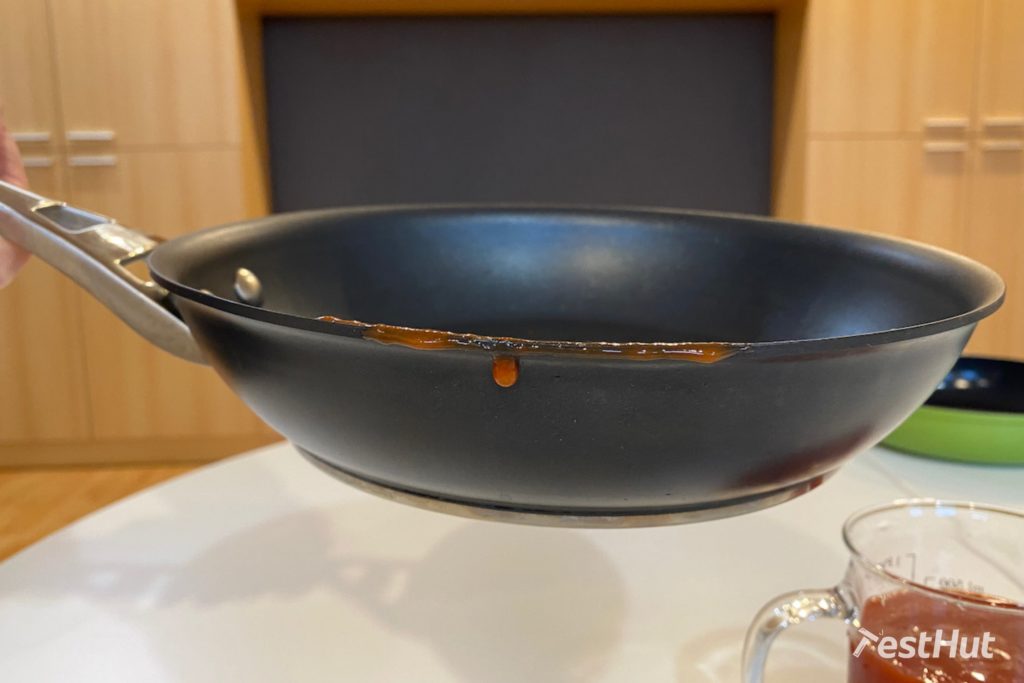
Cleaning this pan was also effortless. At first, we thought that the corrugated surface would gather residue and be harder to clean, but we didn’t experience any problems.
It passed all our durability tests: the handle is tight and durable, and the coating doesn’t scratch easily.
One thing to watch out for is that the Circulon has a riveted stainless-steel handle, and while it provides plenty of room for a full grip, it does get hot, up to 41°C, at the thumb rest.
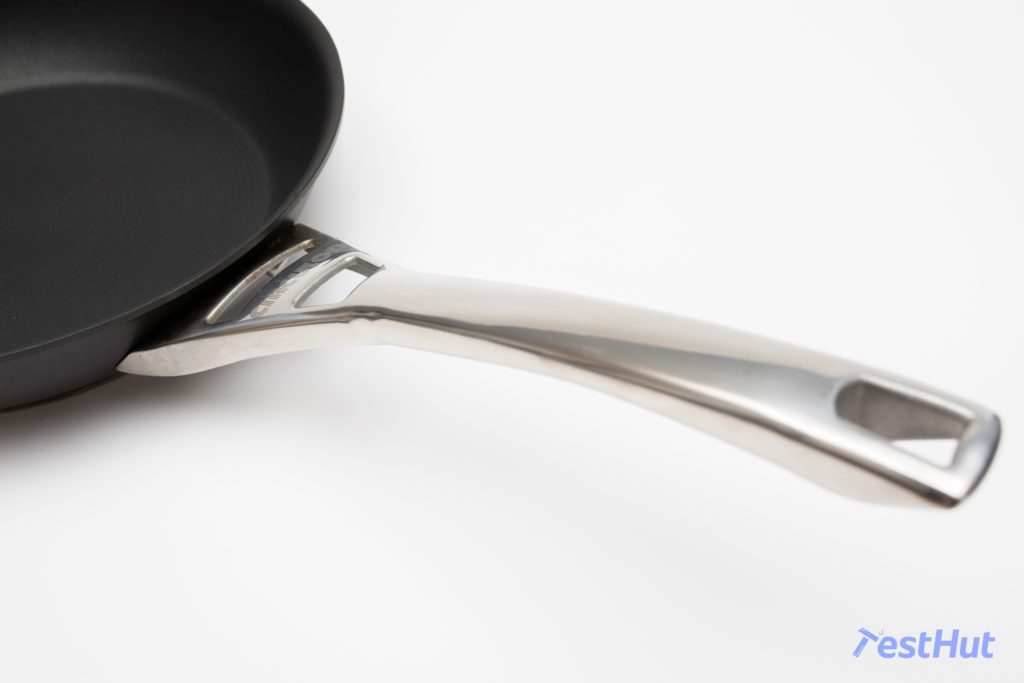
We liked the Circulon from the moment we started using it, and our tests proved that it is the best value nonstick. We believe that this pan, with its durable and effective nonstick surface, is the right choice for most people.
Circulon Infinite French Skillet Features & Specs
- Size: 24 cm
- Weight: 1.1 kg
- Material: Anodized aluminum
- Coating: 3-Ply Teflon
- Handle: Steel with rivets
- Dishwasher safe: Yes
- Metal utensils: No
- Oven Safe: Yes up to 240°C
- Hobs: All (gas, electric, ceramic, induction)
Premium Choice: Swiss Diamond XD Induction 24cm
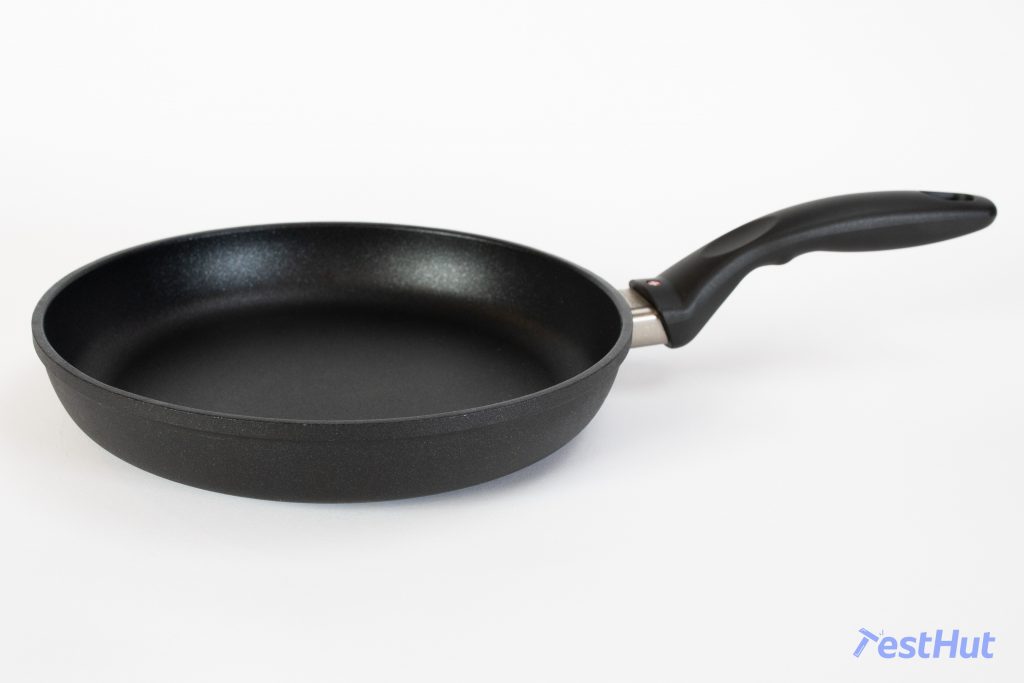
Pros
- Incredible nonstick surface
- Comfortable safe handle
- Very even an steady heating
- Well-balanced
- Durable coating
- Great on induction
Cons
- Sides are a bit steep and shallow
- Only plastic handles available
- Expensive for nonstick
It has an incredible nonstick surface, is durable, and compatible with all hobs. Whatever we decided to cook in the Swiss Diamond XD, the results were excellent!
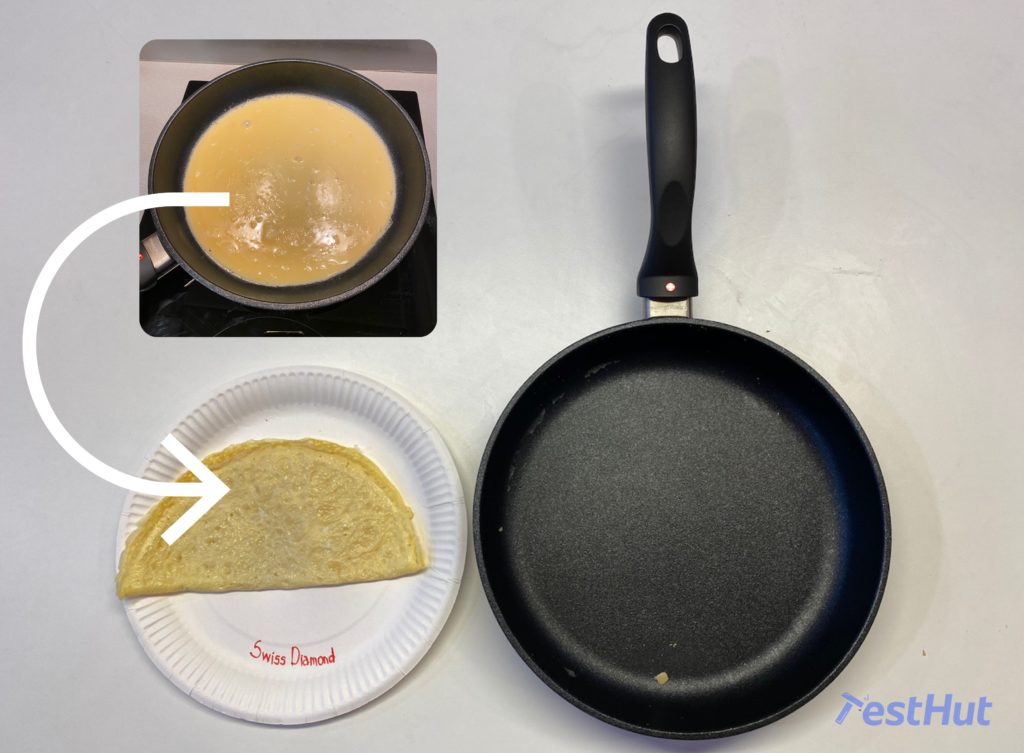
The Swiss Diamond is incredibly steady on an electric stove, and it was the best pan in our test on induction hobs. It heats safely and evenly.
The Swiss Diamond weighs just over 1 kg, which is perfect for comfortable cooking, and the pan is well balanced. Every task with this pan is effortless, including pouring out food and performing pancake flips.
With a comfortable plastic handle and a thumb rest spot, the Swiss Diamond’s handle is very well built providing a comfortable and safe grip.
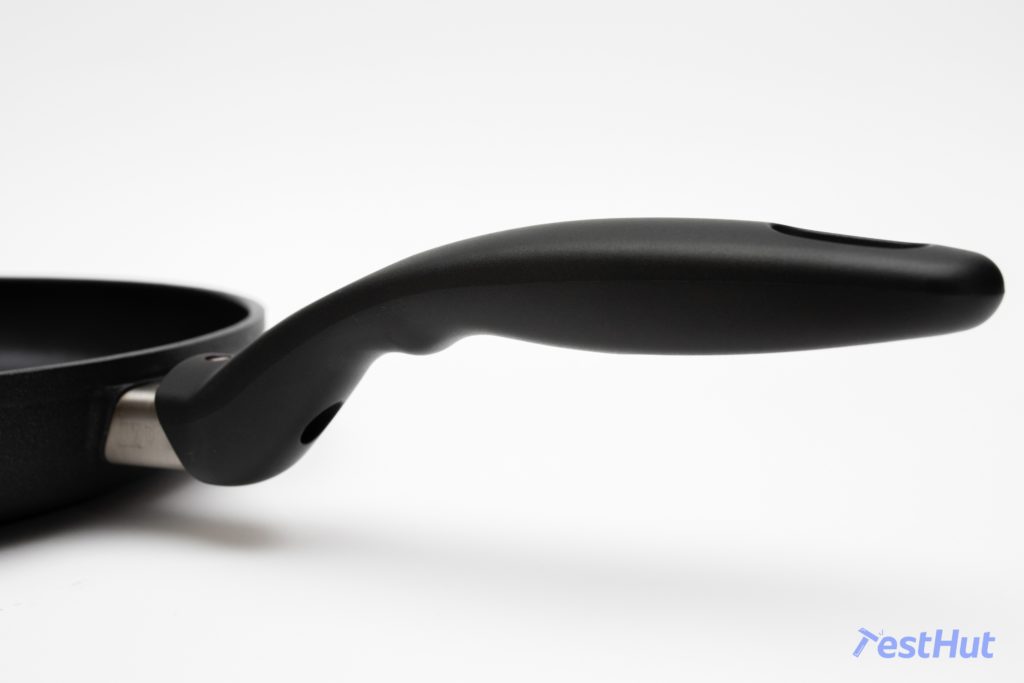
We confirmed that quality is the main feature for Swiss Diamond, and it is flawlessly built from one end to the other. This pan survived all our durability tests, and after many hours of testing and some pretty harsh durability tests, the coating didn’t show any signs of deterioration.
The sleek coating makes every cleaning session extremely easy. There is almost no residue from anything you cook, and you can clean it with just a few gentle strokes with a sponge.
When it comes to aesthetics, the shiny diamond coating says “premium” as it should, considering the price.
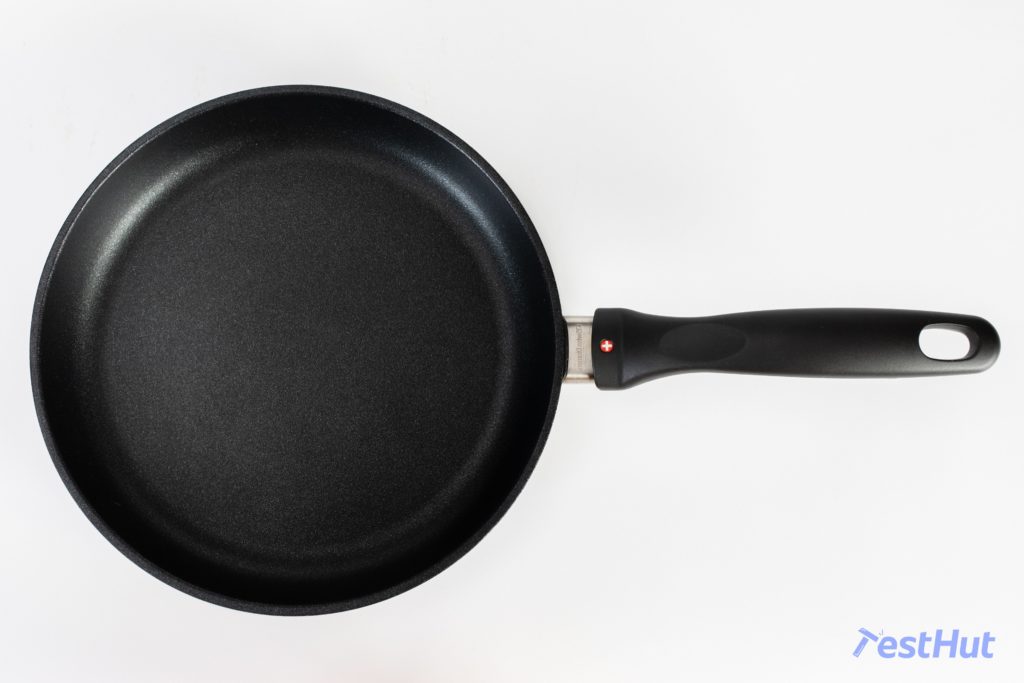
One drawback is that the Swiss Diamond frying pan is not suitable for voluminous foods, like stir-fries because it has lower sidewalls.
The Swiss Diamond XD’s excellent nonstick performance combined with a high-quality build ensures excellent cooking results. If you’re looking for the best of the best, and money is not an issue, this pan will live up to your expectations.
Swiss Diamond XD Features & Specs
- Size: 24 cm
- Weight: 1.1kg
- Material: Cast Aluminum
- Coating: Swiss Diamond XD (PTFE)
- Handle: Bakelite
- Dishwasher safe: Yes (not recommended)
- Metal utensils: Not recommended
- Oven Safe: Yes up to 260°C
- Hobs: Gas, electric, ceramic, induction
Best Budget Nonstick: Tefal Precision Plus 24cm (Not Induction)
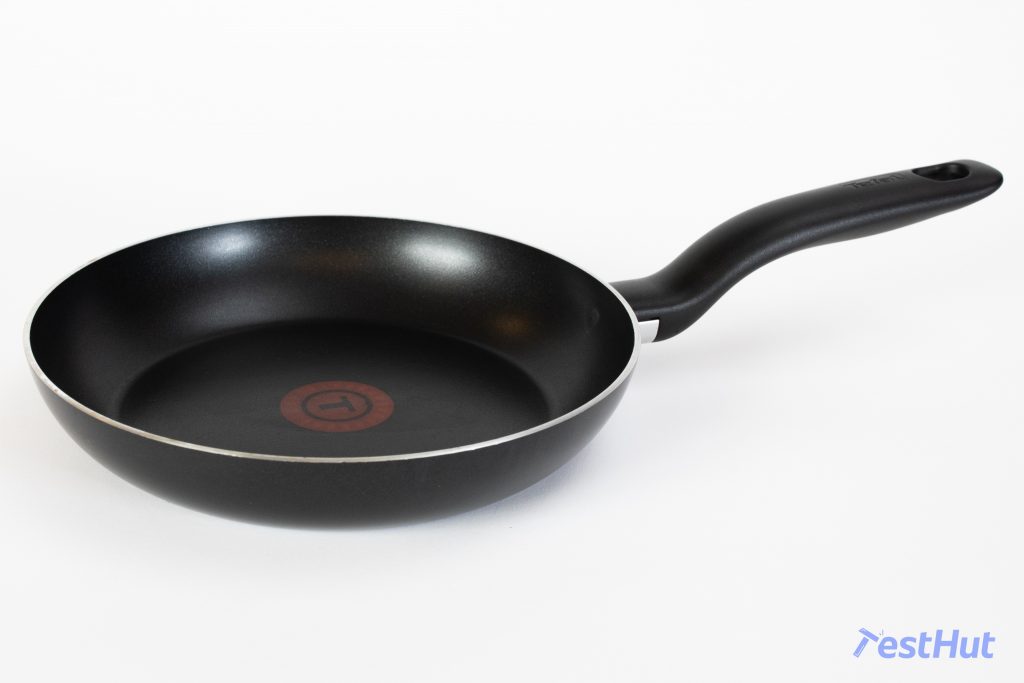
Pros
- Great nonstick surface
- Comfortable safe handle
- Even heating
- Relatively Inexpensive
Cons
- Pan is smaller than advertised
- Only plastic handles available
- Too small for everyday use
- Not very durable coating
- Feels light and cheap
Based on research, we knew that we would have to test the ultra-popular Tefal pans, so we chose an Amazon bestseller, the Tefal Precision Plus 24cm. When we received the pan, we were a little disappointed, because it was smaller than advertised (just 23cm), but the Tefal Precision Plus nonstick surprised us with great results and became one of our Top Picks.
The Tefal Precision Plus frying pan demonstrated an excellent nonstick performance—even a little better than our mid-range Tefal Comfort Max, which is supposed to be a higher-end Tefal pan.
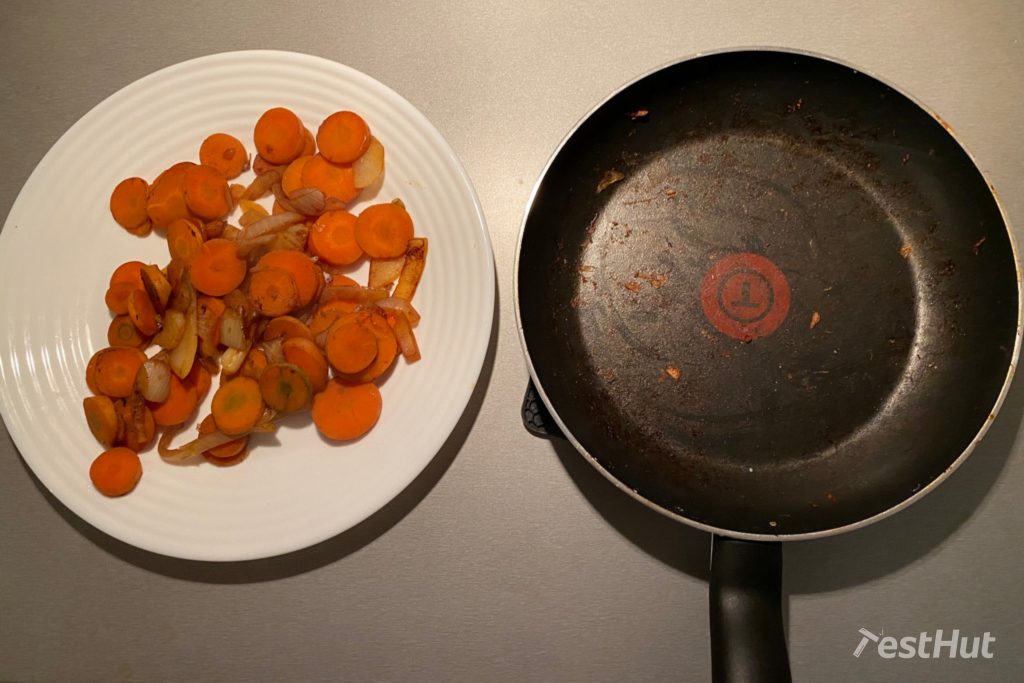
The Tefal Precision Plus is a stamped aluminium pan, so it is thin and heats up fast. Although the overall heat climb is not dangerous, it could affect the cooking result, so lower the heat once the pan is warmed up.
Despite the thin aluminum body, heating evenness was on par with our top-rated Circulon pan.
Weighing only 530 grams, the Precision Plus is easy to manoeuvre, but it is not as stable on the stove as heavier pans, like the Circulon or Swiss Diamond. It has a long plastic handle, which is quite comfortable and safe.
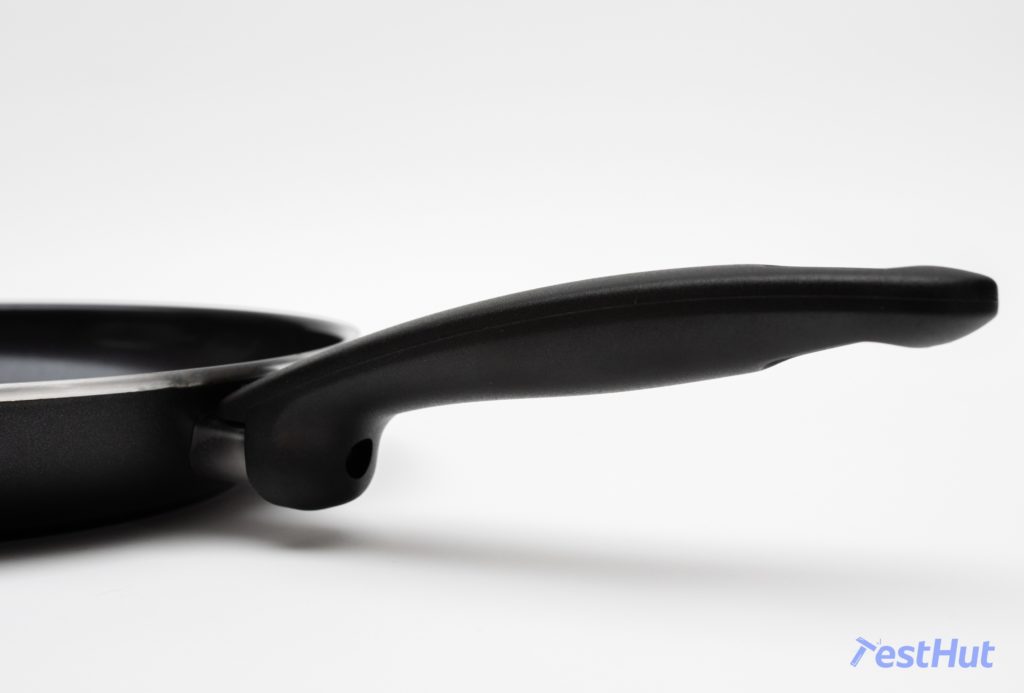
Rounded corners and low side walls contribute to easy and convenient utensil use, and altogether it made pouring foods and liquids effortless.
The coating of Precision Plus is not metal safe, and we accidentally scratched it during our home tests, but we didn’t notice any changes in the nonstick performance. The pan did surprisingly well in other durability tests, surviving the cold-water immersion test without warping, and the handle did not break during our drop test.
The Precision Plus is not induction stove compatible, and it has a low oven rating—the plastic handle doesn’t allow temperatures above 175°C.
Overall, Tefal Precision Plus is a great budget pick, but we suggest ordering a bigger size, at least 28cm if you want to use it as your daily frying pan. Our 24cm test pan is more suitable for breakfast foods like eggs, bacon, and small pancakes.
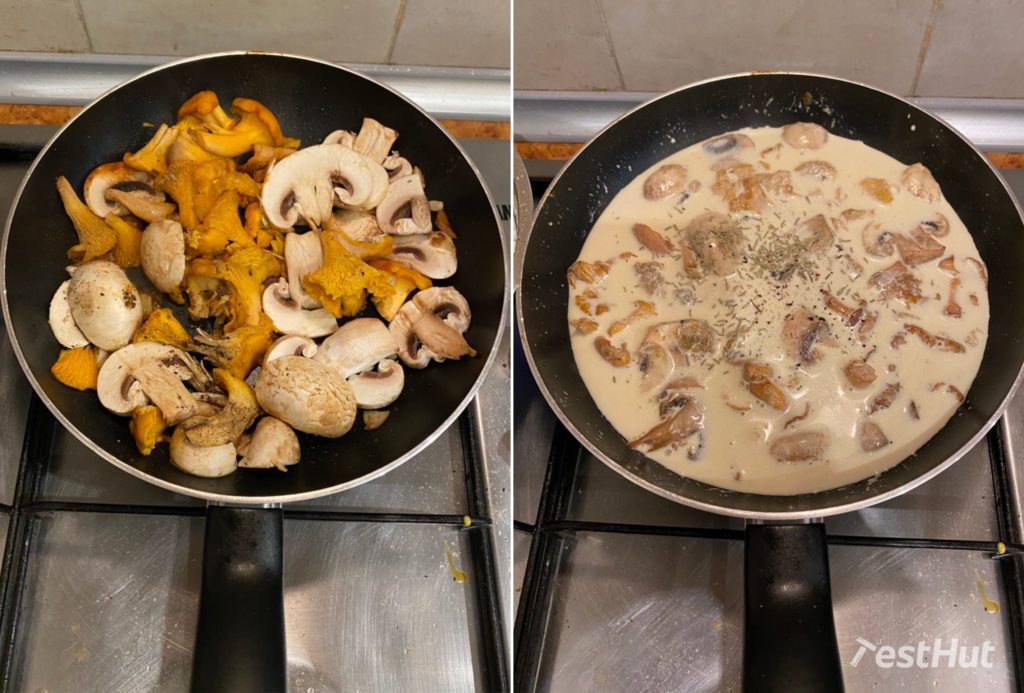
Tefal Precision Plus Features & Specs
- Size: 24 cm (23 cm as tested)
- Weight: 0.53 kg
- Material: Stamped Aluminum
- Coating: Teflon
- Handle: Bakelite
- Dishwasher safe: Yes (not recommended)
- Metal utensils: No
- Oven Safe: Yes up to 175°C
- Hobs: Gas, electric, ceramic
Note: This pan is not induction compatible.
Best Budget Nonstick for Induction: Ikea Trovärdig Nonstick 24cm
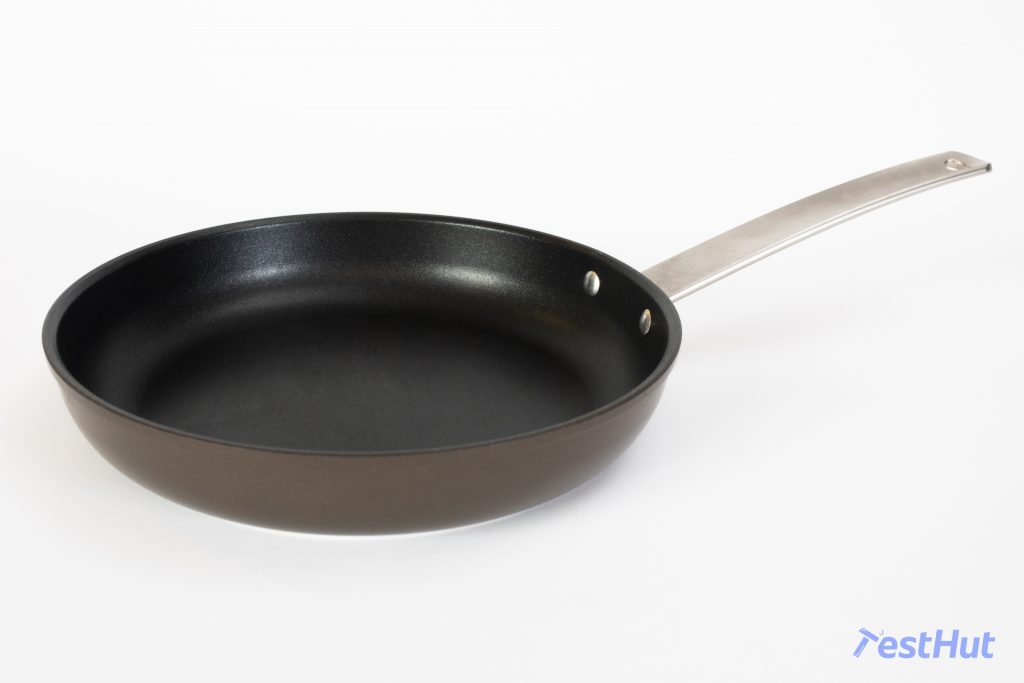
Pros
- Nice looking nonstick pan
- Sturdy metal handle
- Good nonstick surface
- Incredible even heating
- Very good induction performer
Cons
- Food didn’t brown well
- Handle gets warm
- Surface scratches easily
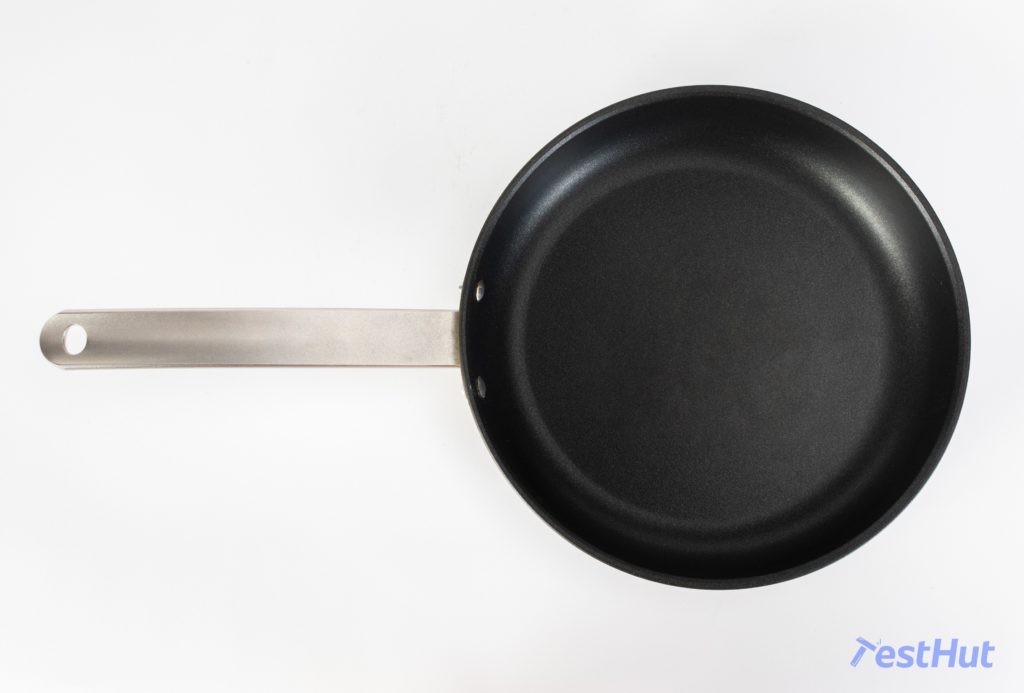
The Ikea Trovärdig had good results in even heating tests. On an induction stove, the difference between the sides and the centre was only 7°C. You do need to keep an eye on it, however, because it will continue to get hotter and hotter over time.
The Trovärdig had great food release—we didn’t experience any sticking no matter what we decided to cook.
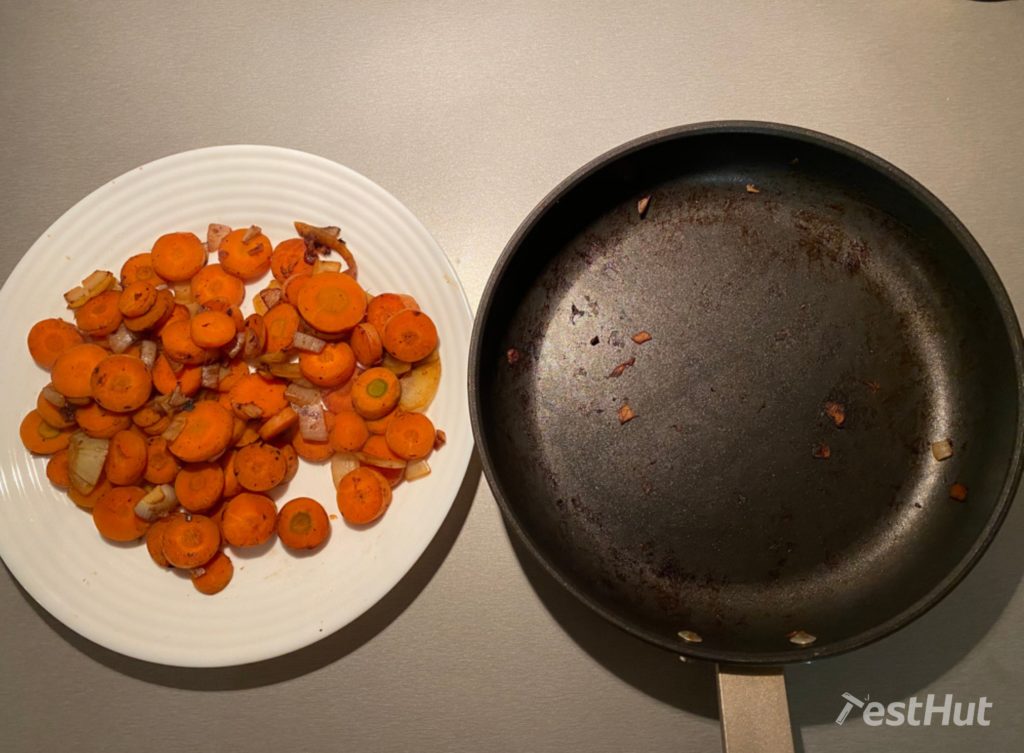
With a versatile shape, its overall capacity is the same as Circulon—up to 2 litres. The pan is well balanced and weighs just below 1 kg. This makes working with the pan comfortable; flipping without a spatula is easy, and cleaning also doesn’t take much effort.
The Ikea Trovärdig is a stylish pan, and it was one of the few nonstick pans that got an above average score for its aesthetics. It has a long metal handle, which gives it a premium look.
The Trovärdig’s good-looking handle is not as comfortable as we would like. The edges stick into your palm and it becomes a little hot during longer cooking sessions. The thumb rest spot heated up to 42°C, which was warm enough to notice. The handle also has no hanging hole for a hook.
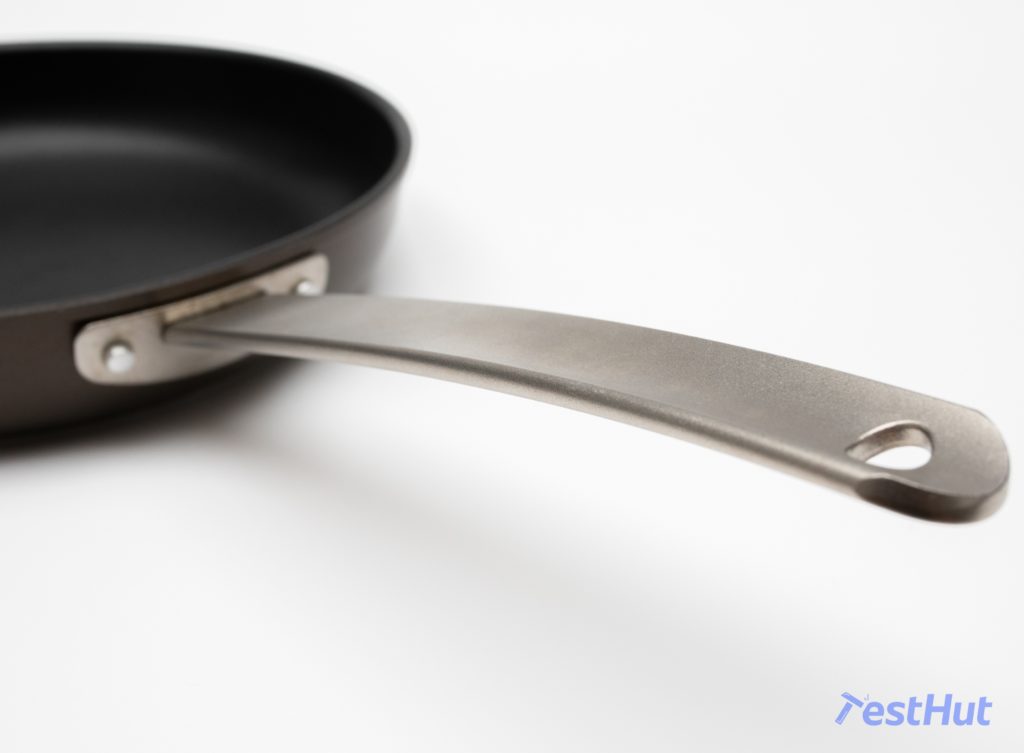
The Trovärdig’s nonstick coating is not as durable as Circulon’s or Swiss Diamond’s scratching easily in our fork test, but if you stick to Teflon-friendly utensils, like plastic, wood, or silicone, the coating should last.
We enjoyed using the stylish Trovärdig—it has a versatile shape holding a lot of food for a 24cm sized pan. If you treat Trovärdig as it deserves, it should last for a few years.
Ikea Trovärdig Features & Specs
- Size: 24 cm
- Weight: 0.94 kg
- Material: Aluminum
- Coating: Teflon
- Handle: Steel with rivets
- Dishwasher safe: No
- Metal utensils: Yes
- Oven Safe: Yes (but no temperature rating)
- Hobs: Gas, electric, ceramic, induction
Best Teflon Alternative: Ozeri GreenEarth Smooth Ceramic Pan 26cm
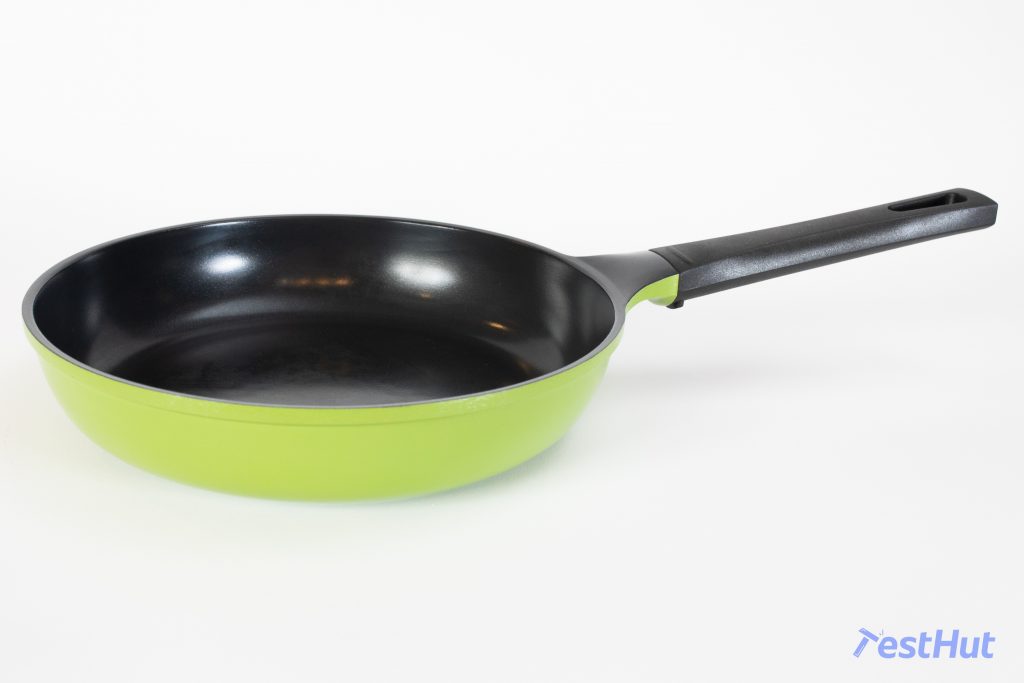
Pros
- Ceramic Nonstick—Teflon Free
- Steady and safe cooking
- Great food release
- Cast aluminum with pouring lip
- Large size—can hold lots of food
Cons
- Unsafe and uncomfortable handle
- Very uneven heating
- Questionable aesthetic design
We tested two Teflon-free nonstick pans with ceramic coating: the Ozeri GreenEarth and GreenPan Cambridge. Although we think that both of these pans are good options, the Ozeri won out thanks to its versatile shape and size.
The Ozeri’s ceramic coating was almost as good as the Swiss Diamond’s, nothing stuck to it—even the softest and most delicate foods.
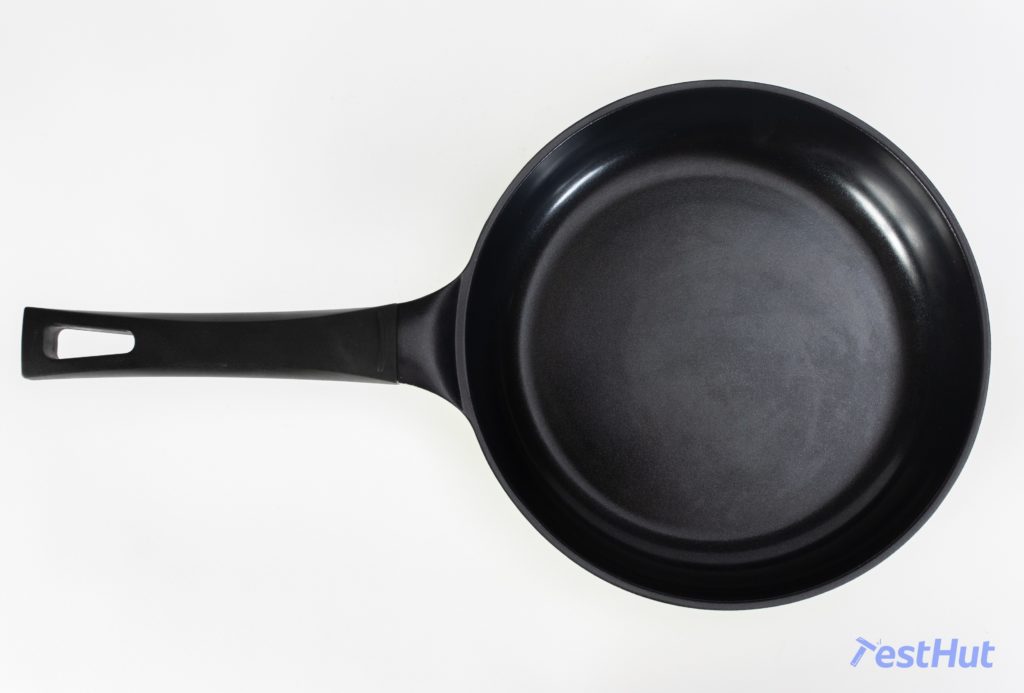
Although the Ozeri did deliver great cooking results, during a long cooking session, the temperature kept slowly climbing; therefore, we suggest lowering the heat to keep the pan from overheating.
The Ozeri was the largest nonstick pan that we tested at 26cm with an overall capacity of 2.5 litres.It is a family-size pan, and it was perfect for voluminous stir fries.
It was easy to access food with a spatula, and pouring sauces and other liquids was effortless with the rolled lip all around.
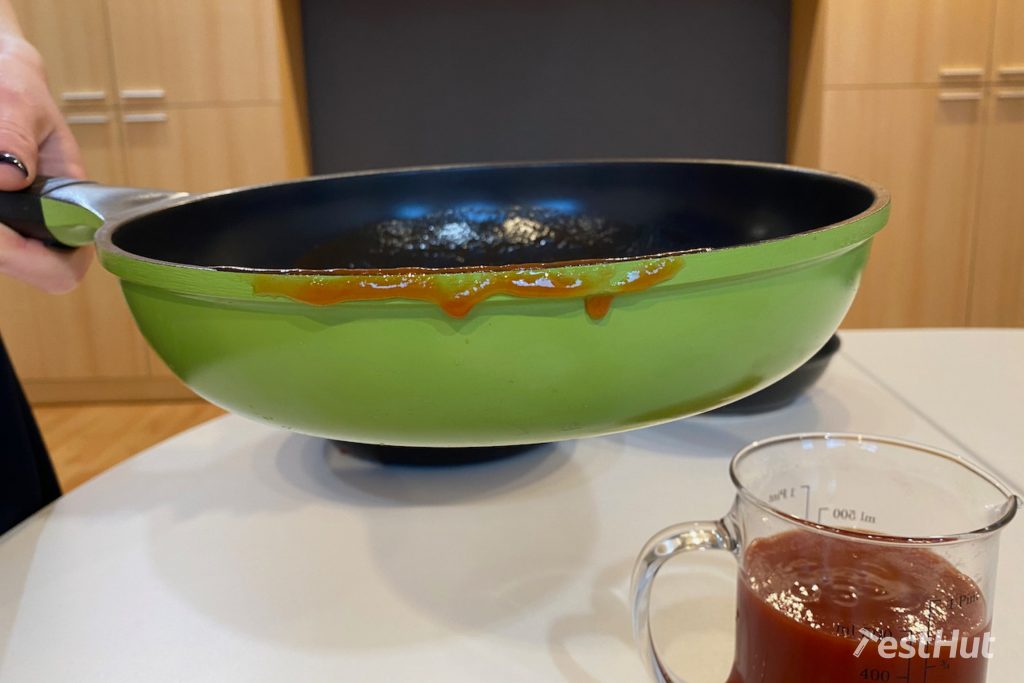
The Ozeri is surprisingly light—just over 900 grams. It is well balanced, and therefore flipping without a spatula was easy and convenient.
The Ozeri’s ceramic coating survived all our durability tests. We didn’t notice any scratches from metal utensils, while even our best Teflon pans had minor scratch marks.
Cleaning the Ozeri was just as easy as other nonstick pans. It is a bit larger with a long handle that makes it harder to fit in smaller sinks.
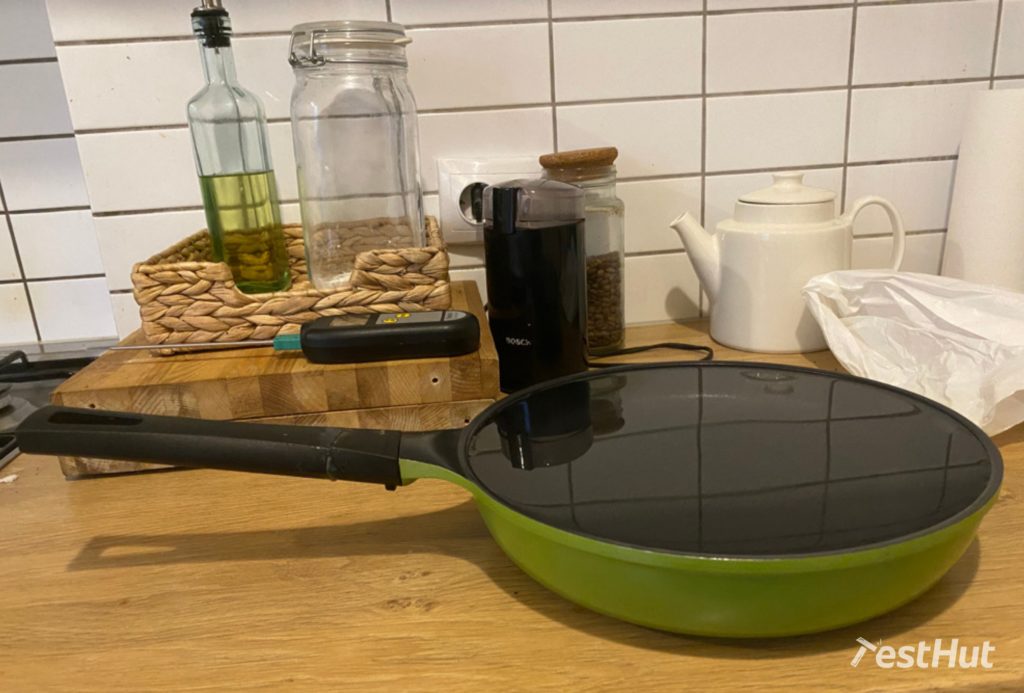
Since the Ozeri is a big pan, its evenness test scores were not as great as other nonsticks. But our biggest issue with the Ozeri GreenEarth pan was its unsafe handle. The Ozeri has an extended cooking area that reaches the base of the handle and gets almost as hot as the inside sidewalls.
The handle was also the only fault when it came to durability tests, snapping off in our drop test.
[videopack id=”1559″]https://www.testhut.com/uk/wp-content/uploads/sites/9/2021/08/Broken_handle-1.mp4[/videopack]The Ozeri GreenEarth is a great choice for a Teflon-free nonstick frying pan, but if you are cautious about the handle, we suggest considering their GreenEarth Textured series pan with a safer handle design.
Ozeri GreenEarth Features & Specs
- Size: 26 cm
- Weight: 0.93 kg
- Material: Cast aluminum
- Coating: Ceramic
- Handle: Bakelite plastic
- Dishwasher safe: Yes (not recommended)
- Metal utensils: No
- Oven Safe: Yes (160°C)
- Hobs: Gas, electric, ceramic, induction
Also good pans
Out of all the test pans, 4 nonsticks from various price groups didn’t receive any badges but performed well in our tests. We believe that these pans are also decent choices.
GreenPan Cambridge 24cm
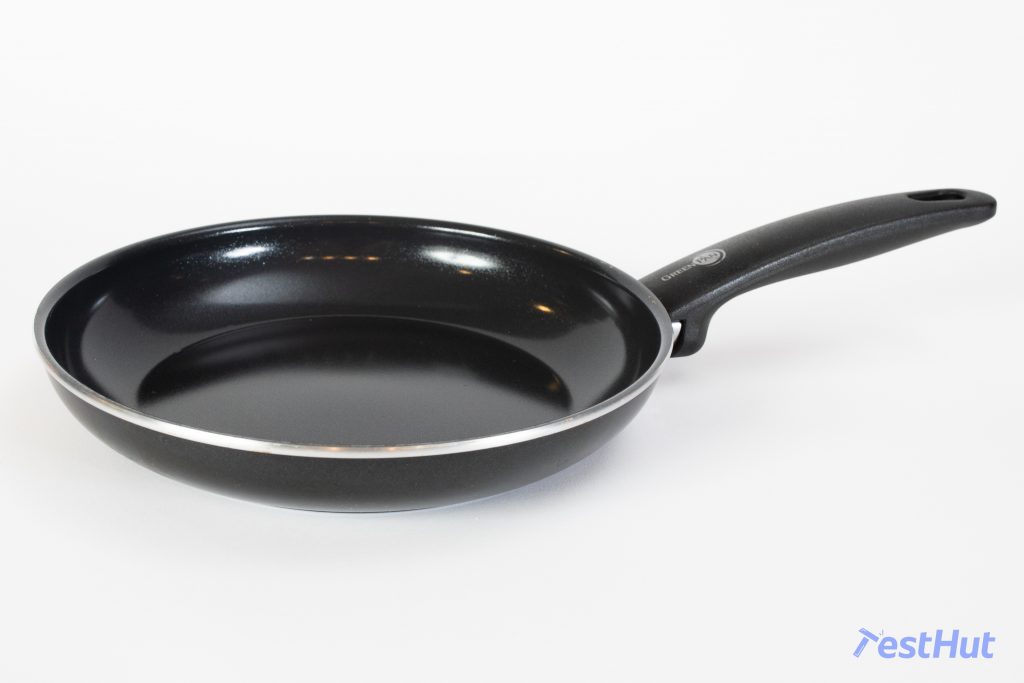
Pros
- Teflon-free Ceramic nonstick
- Nice size and shape
- Easy utensil access
- Great nonstick properties
Cons
- Weak handle weld
- Delicate coating
- Low oven rating
The GreenPan is another Teflon-free pan with a ceramic coating. It performed well in our cooking tests. Just like Ozeri GreenEarth ceramic pan, the GreenPan’s nonstick coating works incredibly well, almost as good as the Swiss Diamond’s and Circulon’s.
GreenPan Cambridge Features & Specs
- Size: 24 cm
- Weight: 0.8 kg
- Material: Forged Aluminum
- Coating: Ceramic
- Handle: Plastic with weld
- Dishwasher safe: Yes (not recommended)
- Metal utensils: No
- Oven Safe: 160°C
- Hobs: All (gas, electric, ceramic, induction)
Scanpan Classic 24cm
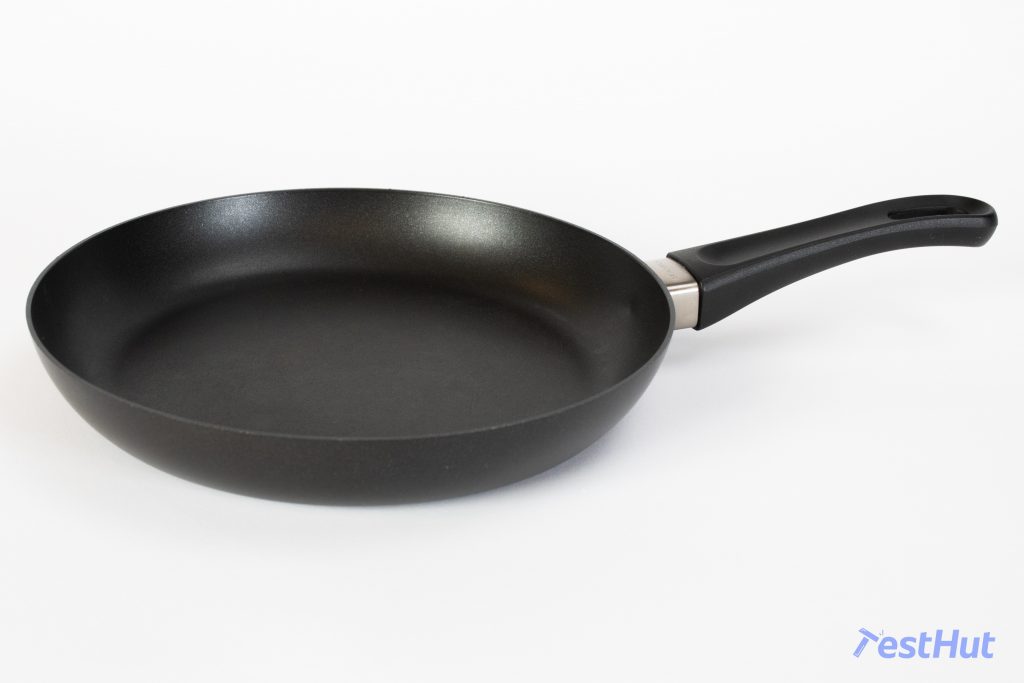
Pros
- Great nonstick properties
- Even heating
- Great browning
- Durable build quality
Cons
- Not induction compatible
- Expensive
- Not a versatile shape
We ordered the Scanpan because it has great professional and user reviews. It scored well in our tests, but it is in our premium price group, and it did not perform as well as the Swiss Diamond. Another problem was that our testing pan was not induction compatible, but Scanpan does offer induction versions of their nonstick pans.
Scanpan Classic Features & Specs
- Size: 24 cm
- Weight: 1 kg
- Material: Cast aluminum
- Coating: Stratanium (Teflon)
- Handle: Bakelite plastic
- Dishwasher safe: Yes (not recommended)
- Metal utensils: Yes (not recommended)
- Oven Safe: Yes (260°C)
- Hobs: Gas, electric, ceramic
AmazonBasics Nonstick 24cm Frying Pan
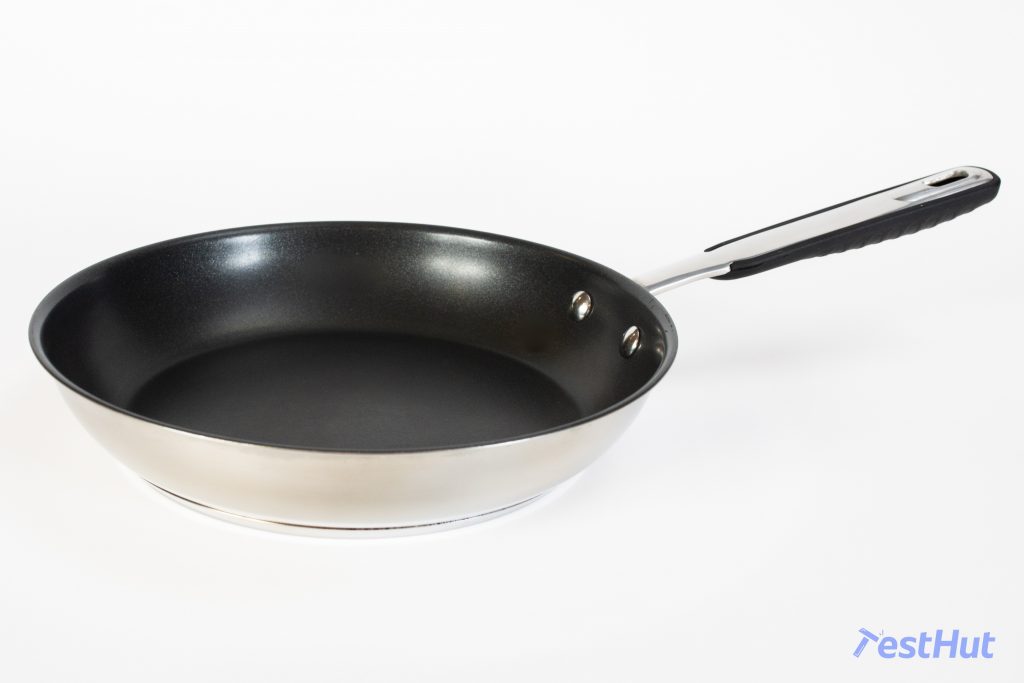
Pros
- Good nonstick surface
- Nice size and shape
- Well-balanced
Cons
- Unsteady heating
- Construction feels cheap
- Very low oven rating
The AmazonBasics nonstick is a very popular and highly rated pan, and it earned a solid overall score, but it didn’t make our top choice list because it had problems with temperature steadiness, especially on an induction hob. The Amazon also has a sleek nonstick surface, but after months of testing, we noticed that the coating started to wear off.
AmazonBasics Features & Specs
- Size: 26 cm
- Weight: 0.89 kg
- Material: Stainless Steel
- Coating: 3 layers of Teflon
- Handle: Steel with Silicone Grip
- Dishwasher safe: Yes
- Metal utensils: No
- Oven Safe: 175°C
- Hobs: All (Gas, electric, ceramic, induction)
Tefal Comfort Max 26cm
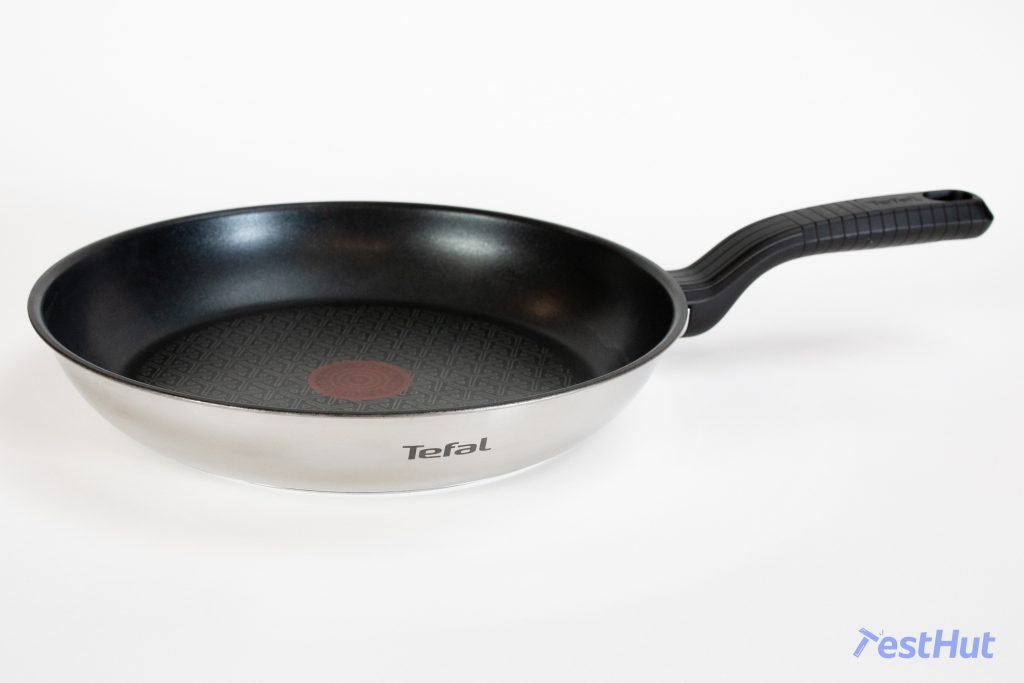
Pros
- Good nonstick performance
- Very even heating
- Holds a lot of food
- Comfortable and safe handle
Cons
- Not well-balanced
- Cheap construction (Handle broke in test)
- Unsteady heating—overheats easily
The Comfort Max nonstick was one of the two Tefal pans we tested, but surprisingly its cheaper cousin, the Precision Plus, performed better. Our test model’s comfortable handle snapped off in the drop test, and we had some problems with heating steadiness. The nonstick performance was excellent, on par with our best pans, and the versatile size and shape are great for cooking big meals.
Tefal Comfort Max Features & Specs
- Size: 26 cm
- Weight: 1 kg
- Material: Stainless Steel
- Coating: Teflon
- Handle: Bakelite with rubberized coating
- Dishwasher safe: Yes (not recommended)
- Metal utensils: No
- Oven Safe: Yes (175°C)
- Hobs: Gas, electric, ceramic, induction
Not recommended
Out of 11 nonstick pans, only 2 pans made the Not Recommended list, mostly because of durability problems.
Zyliss Cook Nonstick 24cm
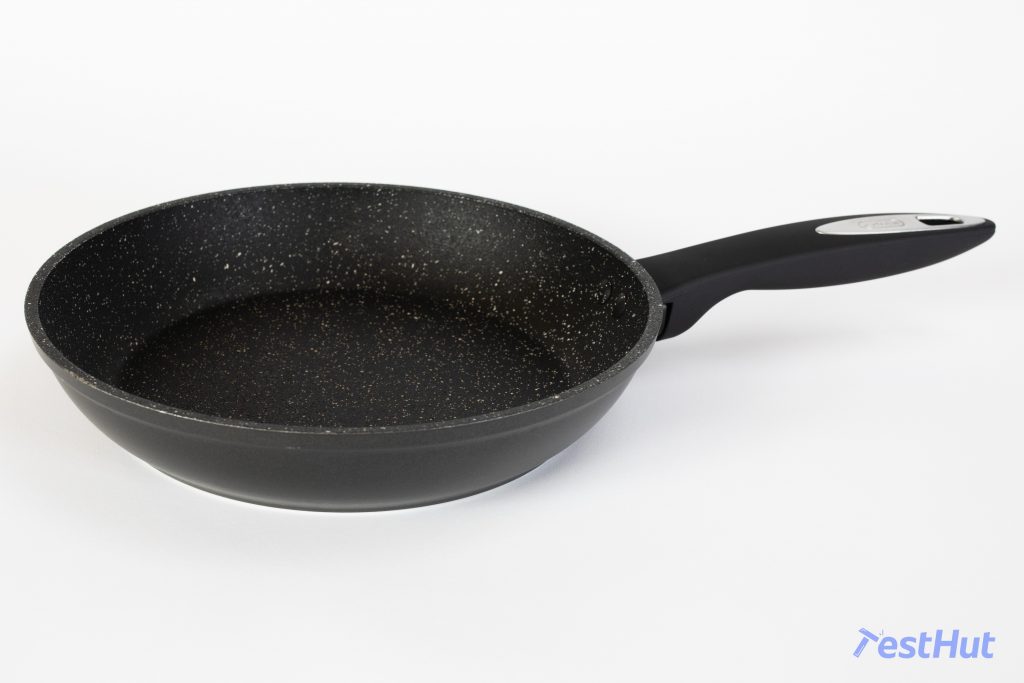
During the testing, it seemed that the Zyliss Cook nonstick pan would be our Best Budget pan. It scored very well in most categories, but it went down hill during our durability tests. While other pans had just minor issues, we basically destroyed the Zyliss pan. The coating lost its nonstick properties after our burnt rice test, and the body of the pan warped in the water immersion test.
Ikea Kavalkad
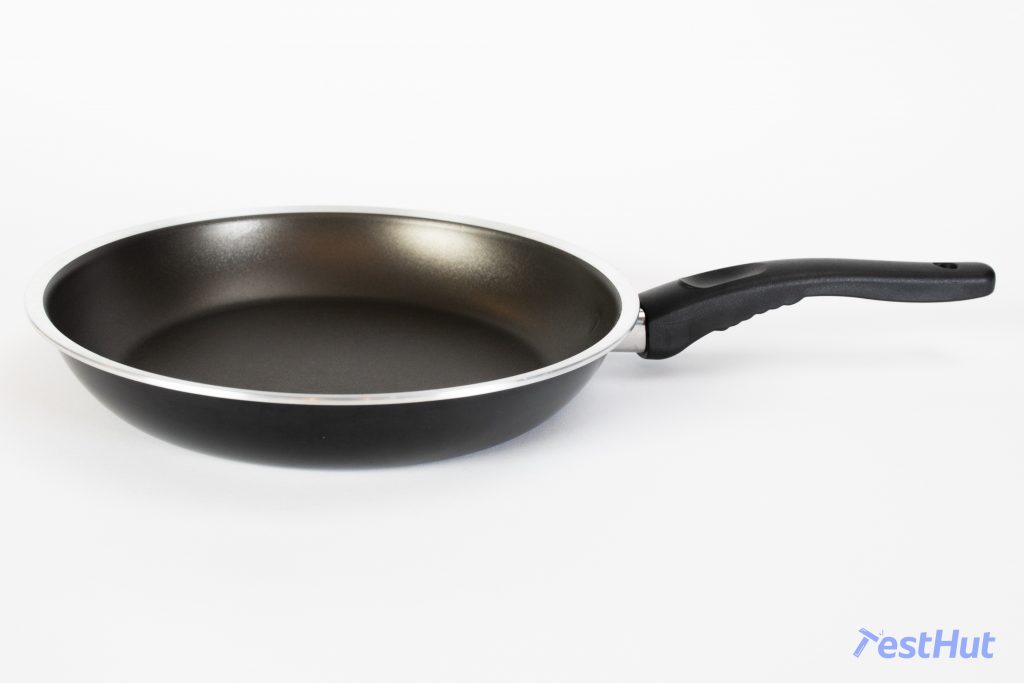
The Kavalkad entered our testing panel accidentally. We picked it up at Ikea when we saw that it cost only 5€. With that said, the Kavalkad did better in our tests than we expected, but overall, we don’t recommend it as a daily frying pan. It will not last as long as our top choices, and it is too small for most cooking tasks.
Nonstick pan buying guide
Finding the best nonstick frying pan that suits your everyday cooking needs is not an easy task. There are thousands of pans to choose from, and manufacturers use confusing product descriptions, like super-strong two-coat Eterna system or triple granite coating. But what does it all mean? Our buying guide will explain the basics of the nonstick frying pan world.
Nonstick coatings
The coating is the essence of a nonstick pan. This is what prevents food from sticking and makes nonstick pans easy to use. The coating will eventually wear down, and there is no way to repair it. Therefore, no nonstick pan will ever work as long as other types of pans. But some coatings are more durable than others.
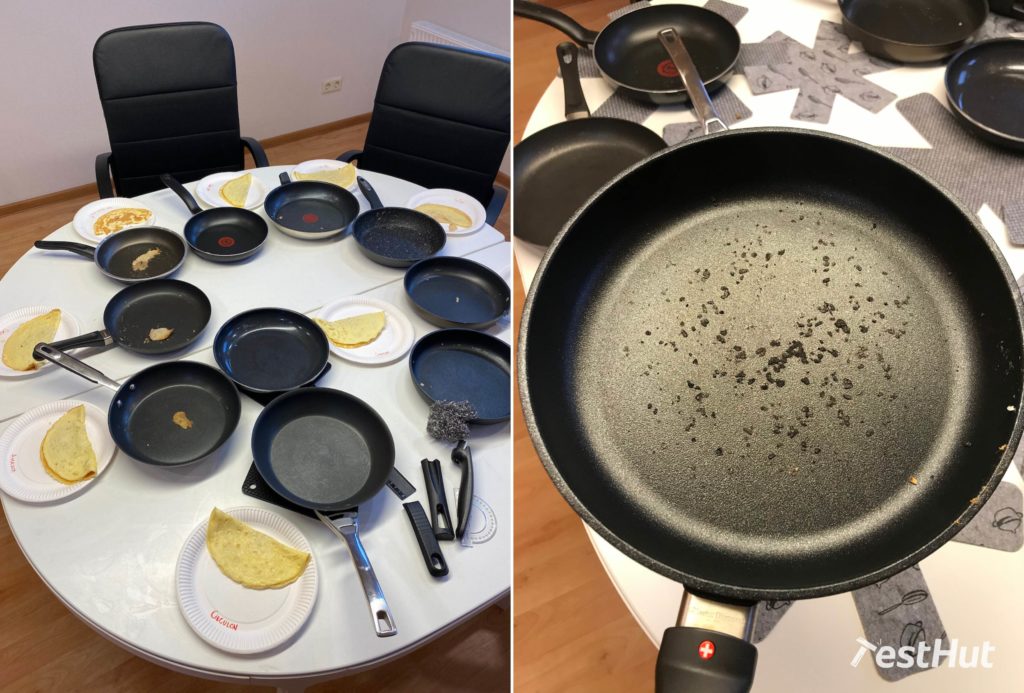
Generally, there are two types of nonstick coatings: PTFE and ceramic. PTFE is commonly known as Teflon, but that is just Duponts’ brand name of their PTFE product. This coating has been around for decades. But due to growing health concerns about the chemicals linked to Teflon, an alternative coating has emerged, ceramic.
Teflon: is it safe?
Historically Teflon was bonded to pans using PFOA or Perfluorooctanoic acid, which is carcinogenic. This predecessor has a lot of lawsuits linked to it about health risks and water pollution. Nowadays, this substance is not used in the manufacturing process of Teflon but be sure, always check if the manufacturer indicates that the pan is “PFOA-free”.
Now manufacturers use Gen X or other synthetic polymers. In simple words, it is thermoplastic. The most popular coating is Teflon, but some manufacturers also use different brands like Eterna or Quantanium. These are also PTFE-based coatings.
Health organizations claim that PTFE-based coatings are safe up to 270°C. Above this temperature, PTFE can start to break down and release chemicals in the air, which may cause flu-like symptoms for humans, but can be lethal for pets, especially birds. So, don’t overheat any nonstick cookware! If used properly, there are no proven risks to humans from PTFE coatings [1].
PTFE is still the most popular type of nonstick coating because it is easily accessible. PTFE coatings, just like ceramic, scratch easily and are likely to flake, but ingesting small flakes of nonstick coating is not considered dangerous. If you want to buy a Teflon pan, look for pans with multiple layers of coating. Those are more durable and will last longer.
Ceramic coatings: A teflon alternative
Ceramic coatings are gaining popularity as a healthier alternative to Teflon. Some say that ceramic still has a lot of disadvantages: it wears off even faster than Teflon and the coating is more prone to sticking. In our tests, we found this to be false.
Ceramic pans can perform as well as Teflon, but there are some differences for sure. The coating is made from sand, which is turned into sol-gel. Since ceramic pans are made of harder, more brittle materials than Teflon, we found that ceramic coatings are harder to scratch; but when they do start to chip and crack, they will wear down faster.
The most popular ceramic coatings are Thermolon and Greblon. But to be sure that the pan is actually ceramic-coated, check to make sure the manufacturer says ‘’PTFE-free’’.
The negative reputation of Teflon has created a wave of misleading marketing claims. Brands use terms like stone or granite coating to make you believe that these pans are natural. But in reality, most of these also are simple coloured PTFE coatings. Only when the manufacturer states ‘’PTFE-free’’ can you be sure that it is ceramic.
Care
No matter which nonstick coating you choose, both ask for specific care. Nonstick coatings are brittle, and when they start to wear off, the pan loses its nonstick performance. To avoid scratching, always use non-metal cooking utensils, like wood, plastic, or silicone. Even if the manufacturer says that the coating is metal safe, we advise sticking with gentler options.
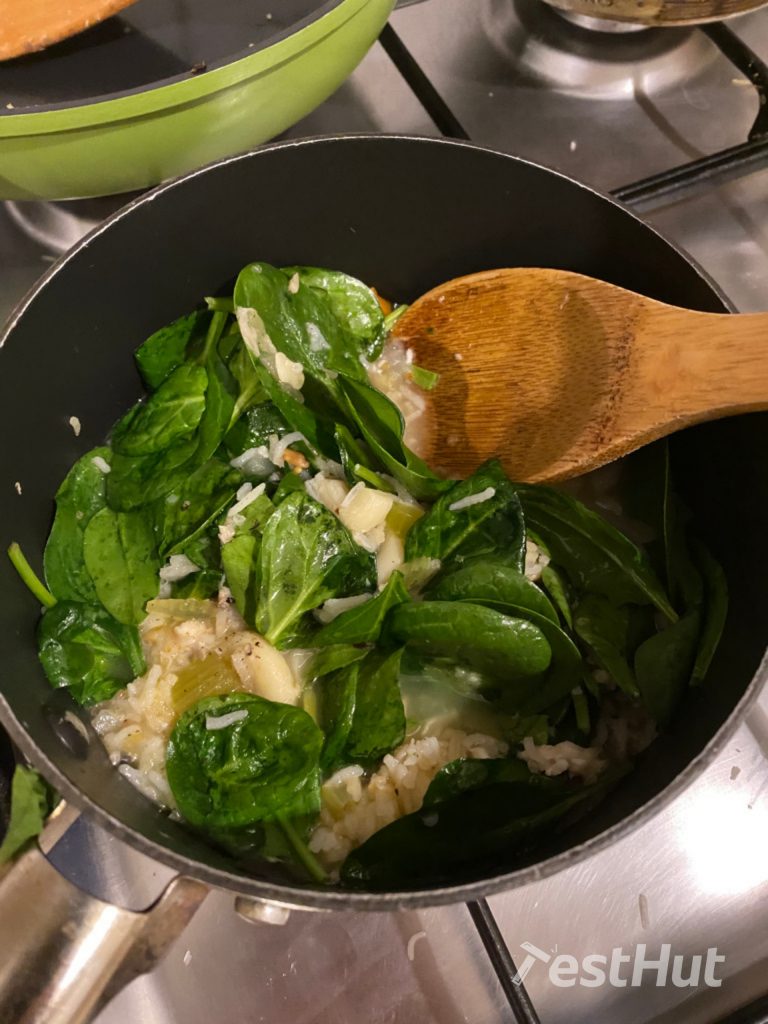
As it is with all types of pans, always cool the pan before washing. With nonstick pans, we suggest avoiding machine washing. Although some pans claim to be dishwasher safe, we believe that it wears down the coating faster. Instead, wash by hand with soapy water and a gentle sponge. Never scrub.
To avoid accidentally scratching the coating when storing the pan, always use some kind of protective layer between the pans if you put them in stacks. A simple paper towel will be enough, but you can also purchase pan protectors in all shapes and sizes.
Construction of the pan
More factors contribute to an excellent pan than just the coating. To ensure even heating and steady temperature, the material of the pan is important. Generally, nonstick pans are made of either aluminium or stainless steel.
Aluminium pans are usually cheaper, but their quality depends on the manufacturing process. Stamped aluminium pans are very thin, they are not as durable, but people chose them because of the low price. They are more likely to warp. Forged aluminium pans are heavier and less prone to warping. Cast aluminium pans are high quality and the most durable, which also reflects a higher price point.
The last type of aluminium pans is anodized. The making of anodized pans includes one of the methods mentioned above, but the aluminium is hardened to be less reactive and more durable.
Although aluminium pans are cheaper, the material itself has great heating properties. Usually, they heat up fast and are responsive to temperature changes.
Other nonstick pans are made of stainless steel, which is not a great heat conductor alone. Therefore, stainless pans have a layer of aluminium, or other types of metal bonded to the body. Stainless pans divide into clad and disc pans. Clad pans have a reputation for quality and better heating performance. We tested two nonstick stainless steel pans with a disc bottom. These pans tended to get hotter faster, which is not safe for PTFE coatings.
Most nonstick pans will be suitable for electric, ceramic top, and gas stoves. Induction users have to check if both aluminium and stainless nonstick pans work on induction. These materials need an additional plate of a magnetic metal to work on an induction stove.
What size do I need?
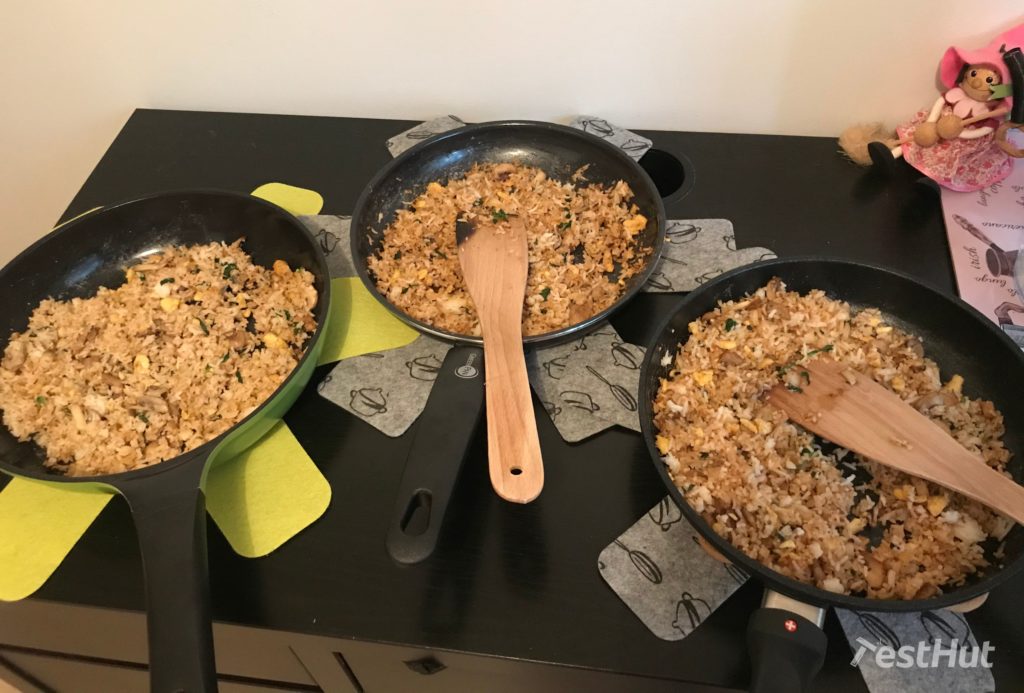
The size of the pan is very important to avoid overcrowding the food. The most common sizes are 24cm and 26cm, which will suit most people. This size will be enough for 2-3 people. If you’re cooking for a larger family, choose a 28cm or even 30cm pan, but be sure that you have a hob that supports such a size.
Smaller pans like a 20cm diameter pan, will be more suitable for breakfast, pancakes, etc. Even if you are cooking for 1-2 persons, we advise getting at least a size 24cm to comfortably cook, flip, and stir without spilling.
The shape of the pan impacts the actual size of the cooking surface. Nevertheless, manufacturers still use overall diameter instead of the cooking area. If your chosen pan has wider sidewalls, the cooking area will be smaller.
How much should I pay?
The price of nonstick pans ranges from just a few pounds up to hundreds. In our tests, we found that the price directly correlates to the overall quality of the pan. But before rushing to buy a pan for 100 pounds, be aware that none of the nonstick pans will last more than a few years.
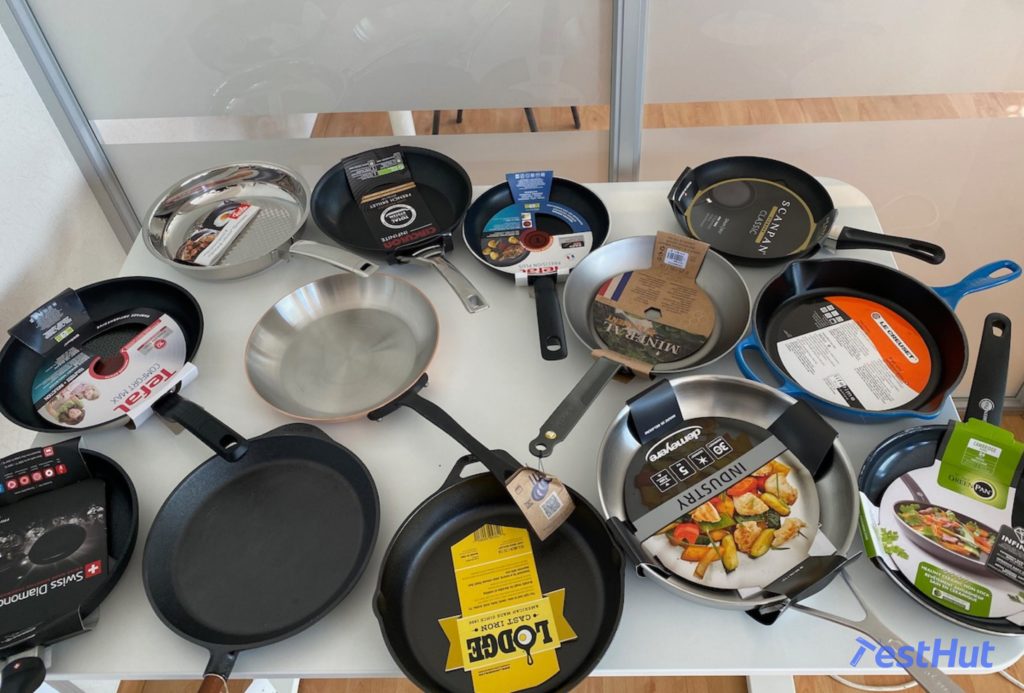
Generally, a quality nonstick pan will cost 35-50 Pounds. Cheaper pans will work fine for a while, but they will probably be less versatile and not as comfortable to use.
Conclusion
If you want to buy a nonstick frying pan, first, decide if you are comfortable with the PTFE (Teflon) coating or the ceramic. Consider the price you are willing to pay while considering that no nonstick pan will last forever. Look for durable pans (forged or anodized aluminium) with multiple layers of coating. But most importantly, always remember to use your nonstick with care to extend its life.
Nonstick frying pan research
To find the best nonstick frying pan for everyday, all-purpose use, we started by expanding our knowledge about the niche—from scientific research about heat distribution and retention to differences between nonstick coatings. We talked to professional chefs to understand what is essential while cooking at home. We considered main factors, like aluminium vs. stainless steel pans, Teflon vs. ceramic coatings, and bakelite vs. metal handles. Do these things matter? Yes.
When we understood the basics of the enormous frying pan world, we turned to other professional review sites and looked at their top choices. We gathered the best pans from trustable international testing sites and took notes about their performance in various areas, including nonstick properties, ease of use, and versatility. We looked for the most popular and widely reviewed choices in the largest online marketplaces. We analysed user reviews and searched for pans with great feedback about build quality and coating durability. We dug deeper and compiled not so popular choices with good reviews to search for hidden gems.
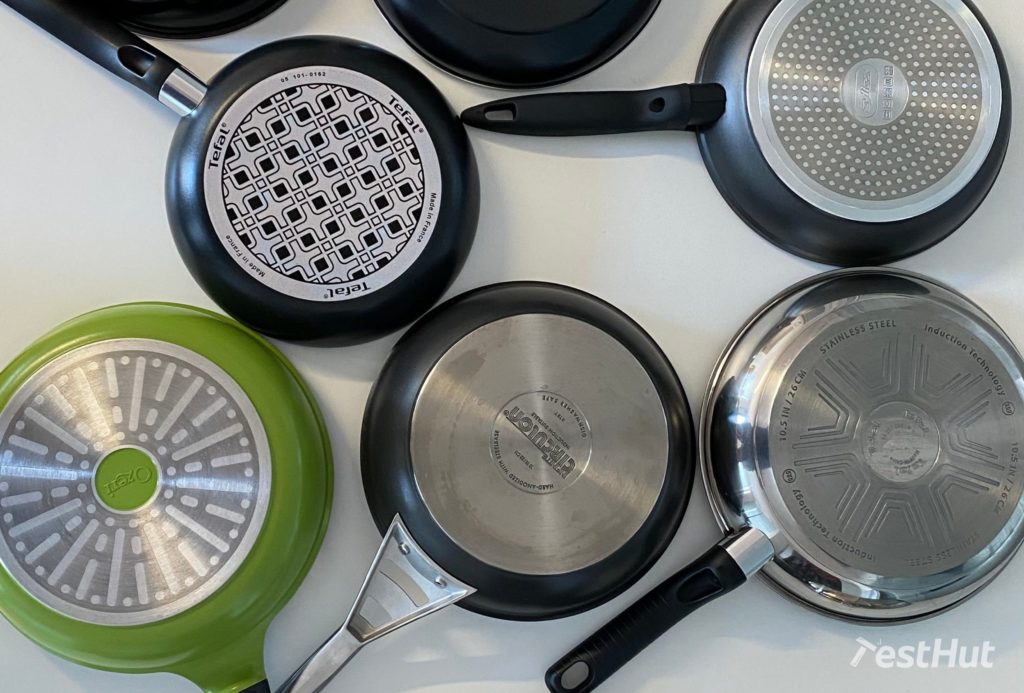
We spent weeks understanding the nonstick pan niche and made sure to list every promising frying pan. To find the best pan, we wanted to test different types of coatings including various types of Teflon and ceramic. Most professional reviews claim that ceramic coatings cannot compete with Teflon in nonstick performance, and that they are not as durable. We wanted to test this theory ourselves. Furthermore, we wanted to try pans made of different materials, like aluminium or stainless steel, to understand how different materials affect cooking performance and long-term durability.
We picked out the most durable pans with great user reviews and analysed overall brand reliability. Since there are thousands of nonstick pans available, we chose well-known brands with proven quality.
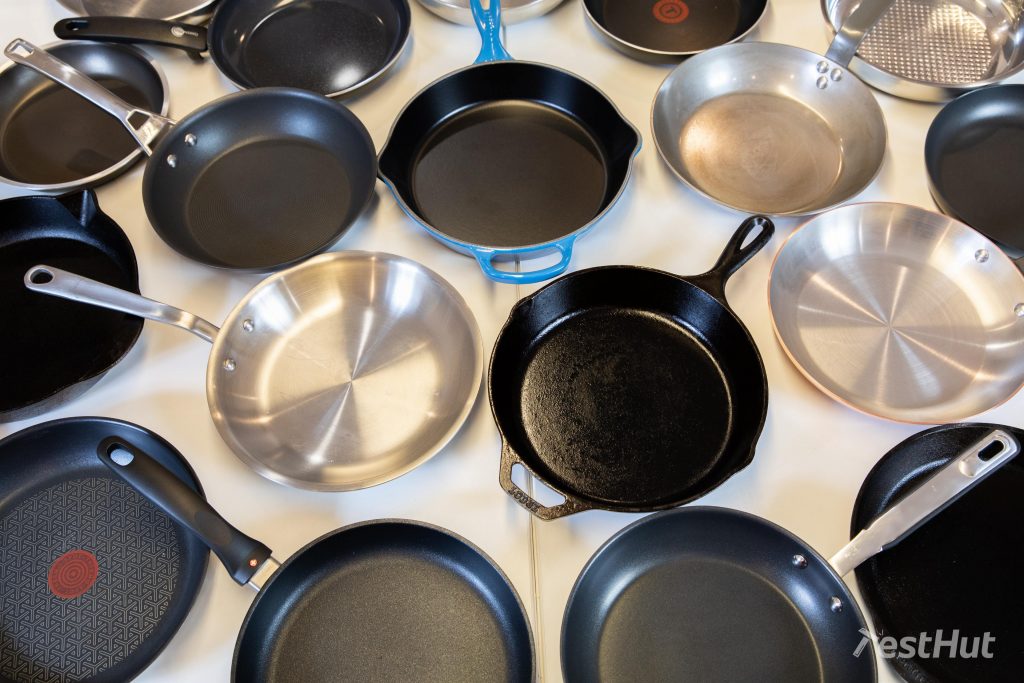
We decided to order medium-sized pans from 24cm to 26cm. This size is large enough for most people without crowding the food, and at the same time, it will fit most stoves and heat evenly.
One of the biggest questions for us was if paying more means higher quality, so we looked at different price ranges and divided our list into three groups: budget, mid-range, and premium. In our final list of 10 nonstick pans, we included multiple choices from each price group that are readily available in Europe. And our curiosity spiked when we went to Ikea to pick up one of our final choices, the Ikea Trovärdig, and we saw their 4 pounds Kavalkad frying pan. We purchased it to have a benchmark for other budget picks. Ultimately, we ended up with 11 pans ranging in price from 4 pounds to 100 pounds.
How we tested
To determine the best everyday nonstick frying pan, we completed a number of tests on 3 of the most popular hob types: electric, gas, and induction. Each of TestHut’s team members has a different cooking experience and skillset—we range from a complete beginner to a passionate cook. This diversity helped us to determine which pans are the best for most people.
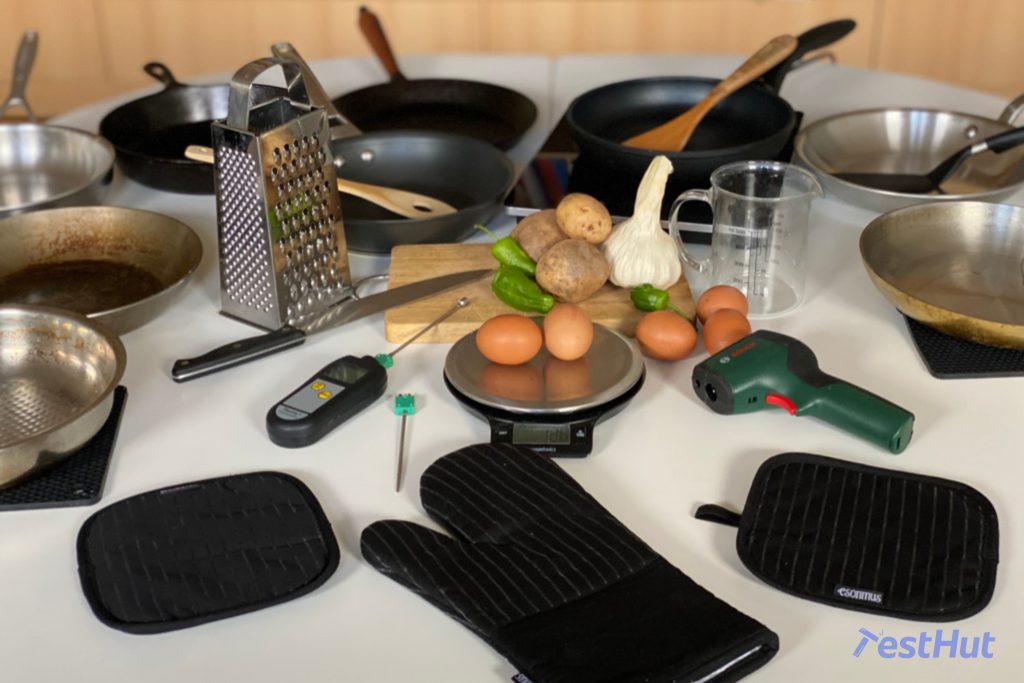
We examined and compared pans in various tasks, but here at Testhut, we believe that each product has its one main purpose. For frying pans, of course, it is cooking food, and it is a given that nonstick pans should do this without sticking.
In addition to cooking, we did a series of other tests that helped us to compare the pans in various criteria. We tested and scored each pan in the following categories:
- Cooking Performance (40%),
- Durability (20%),
- Ease of Use (15%),
- Cleaning and Maintenance (15%),
- Versatility (5%),
- Design (5%).
Cooking Performance
Our most important category, Cooking Performance, included testing multiple factors, which in one way or another contributed to the cooking result: even heating, temperature steadiness, food release, and, of course, we also tasted and examined the food itself.
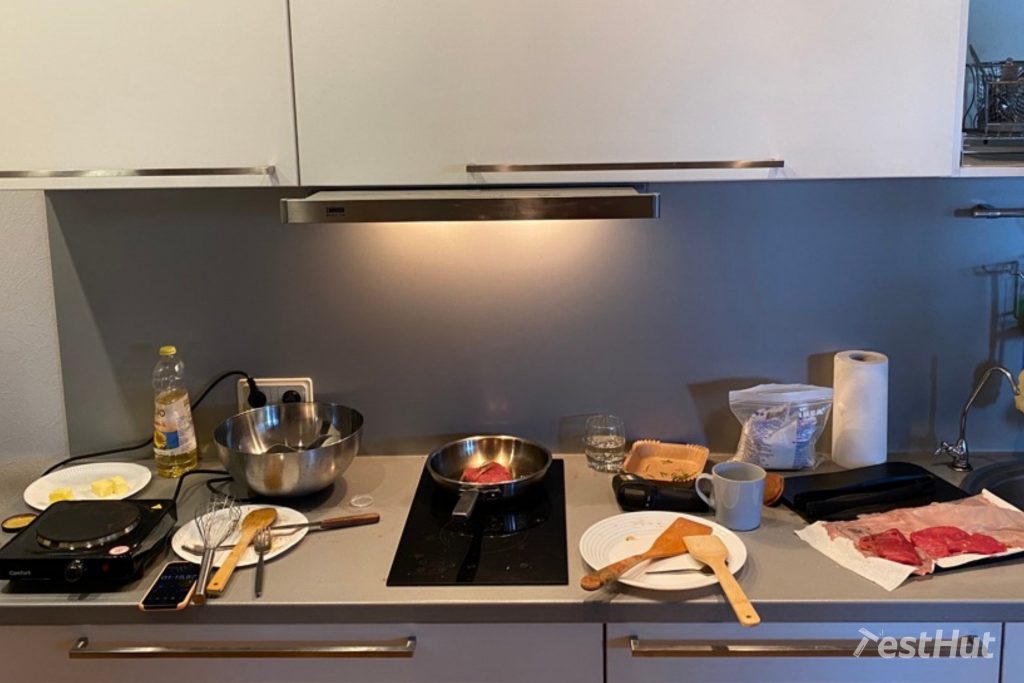
We made pancakes to test the browning pattern of each pan, and while some pans made perfectly crisp and golden-brown crepes, others made pale and soggy imitations of pancakes. We stir-fried vegetables and saw how some pans can burn our food from the outside while not cooking it on the inside. We browned chicken to see if a nonstick pan without oil can deliver the same quality as other frying pan types that use oil, like stainless steel and cast iron. Spoiler—it turns out, yes, they can.
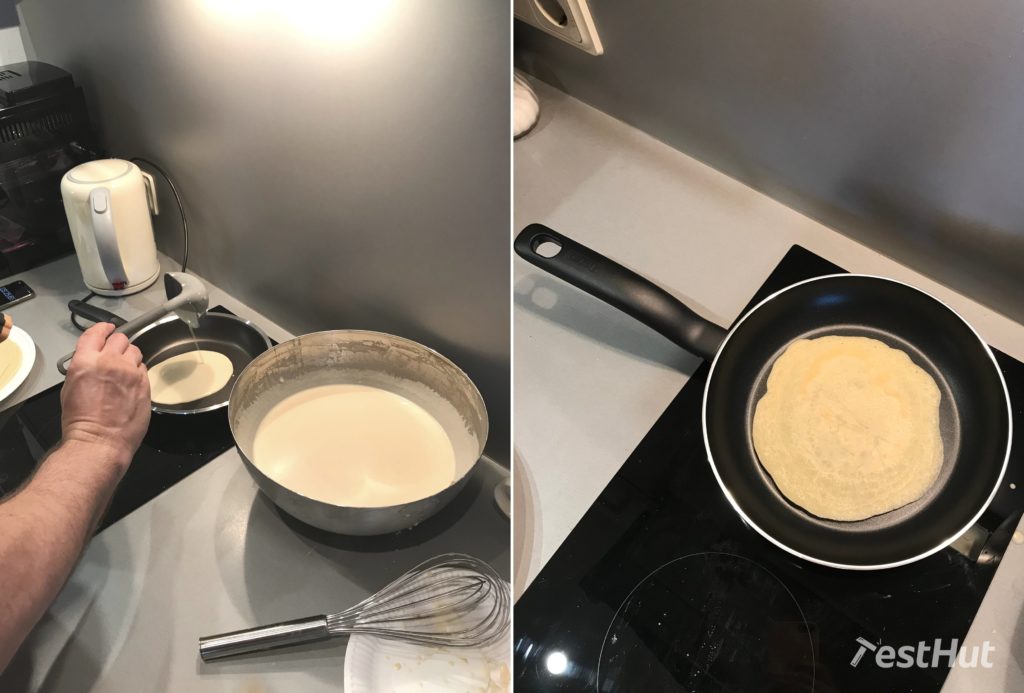
In addition, all of the team members took home each pan for a fewdays to see how these pans would handle more complex foods. We made our favourites, starting from burgers, hash browns, and vegetables to pan sauces, fried rice, and steaks. We saw the differences between pans, and also concluded that nonstick pans aren’t limited to eggs and fish fillets; you can cook all sorts of foods and use your nonstick pan for everyday cooking as well.
Although every cooking test contributed to both cooking results and food release, some tests focused more on the properties of various types of nonstick coatings. We made fried eggs, full pan omelettes, and scrambled eggs without a drop of oil. And once all the testing was done, we repeated the fried egg test to determine if the coating had suffered any wear.
To test the temperature evenness, we heated a thin layer of flour in each pan until we saw the browning pattern. Differences were clearly visible, but we decided to do a longer cooking session with a half-empty pan and measure the temperature at multiple spots on the surface. The second test gave us precise results and confidence about the best pans.
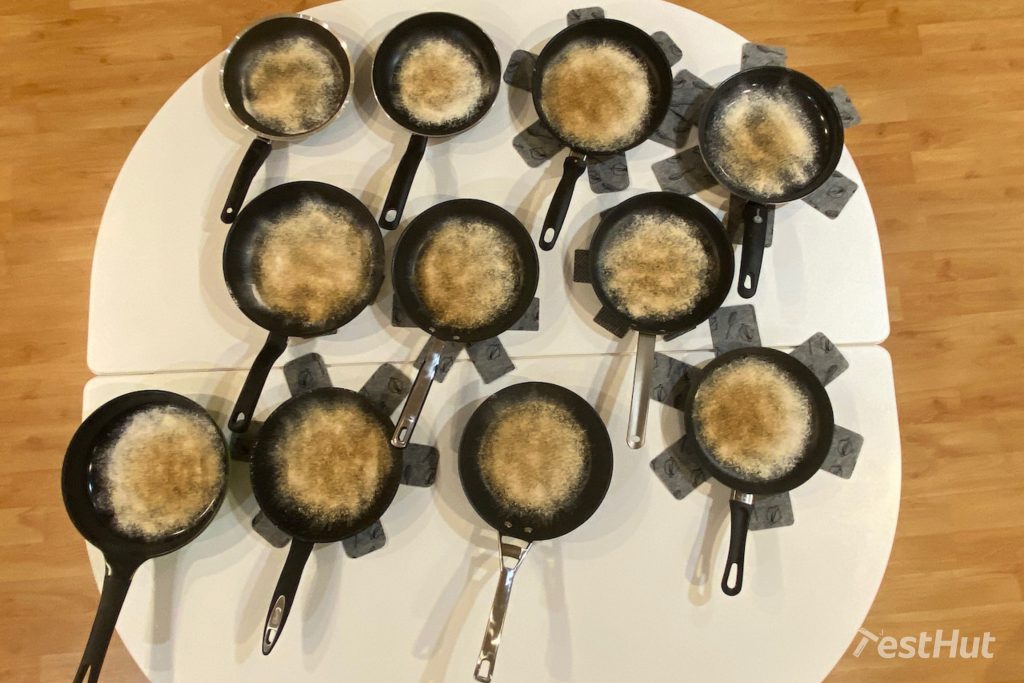
To explain why some pans burnt the food without actually cooking it, we did a temperature steadiness test. While temperature-related factors are mostly dependent on the cook (because you can always adjust the heat), we noticed that some pans just scorched our food faster than others. So, we looked at temperature rise and fluctuations on medium-high heat and proved that some pans are harder to control. It is no surprise that these were the same pans which scored low in our food quality tests.
Durability
The second most important category was Durability, and while it is clear that nonstick pans will not last as long as other types of cookware, we still wanted to find out which of our nonstick contestants are the most durable. We tested the durability of the coating by scratching the pans with metal utensils, we burnt rice and scraped it off with no mercy. We even tried to melt candies and scrape them off the pans, but we concluded that this test didn’t give us different results than the burnt rice test.
To test the build durability of the pans, we dropped them on the kitchen floor, and while some did not show any damage, others had dents and broken handles. We imitated real-life use by submerging hot pans in a cold-water bath and checked for warping. We saw that only one pan didn’t pass this test while others (even the cheapest pans) survived.
[videopack id=”1569″]https://www.testhut.com/uk/wp-content/uploads/sites/9/2021/08/chicken_cooking-2-1.mp4[/videopack]Ease of Use
In the Ease of Use category all nonstick pans had good results, but not all of them were excellent. Most importantly, we examined each handle and looked at several factors: handle comfort and handle safety, which includes both how hot the handle got in various spots and how it is shaped to prevent accidentally touching the hot parts.
We weighed each pan and picked them all up again and again to determine which were the best balanced. We flipped eggs from all corners of the pan to understand how easy it was to access with a spatula.
Next we did a heat climb test, how hot the pans can get on medium-high heat—this showed us how careful the user has to be with each pan and how often the heat setting should be altered. For example, some stainless-steel disc pans (pans with a thick disc bonded to the bottom) got way too hot too quickly on the induction stove; we experienced temperature jumps from 230°C to 270°C in 2 minutes. For nonstick pans this test is especially important since Teflon should never go higher than 270°C, otherwise, it can release dangerous fumes that can harm your health.
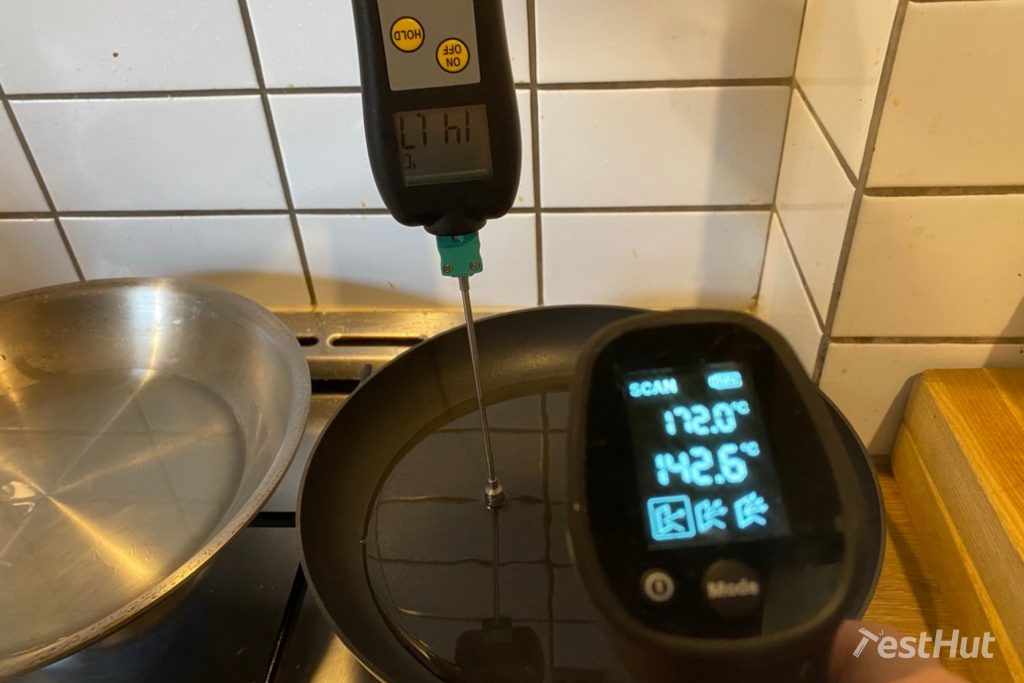
As the last test in this category, we measured how long it takes to heat the pan up to 200°C on an electric stove and an induction stove.
Cleaning and Maintenance
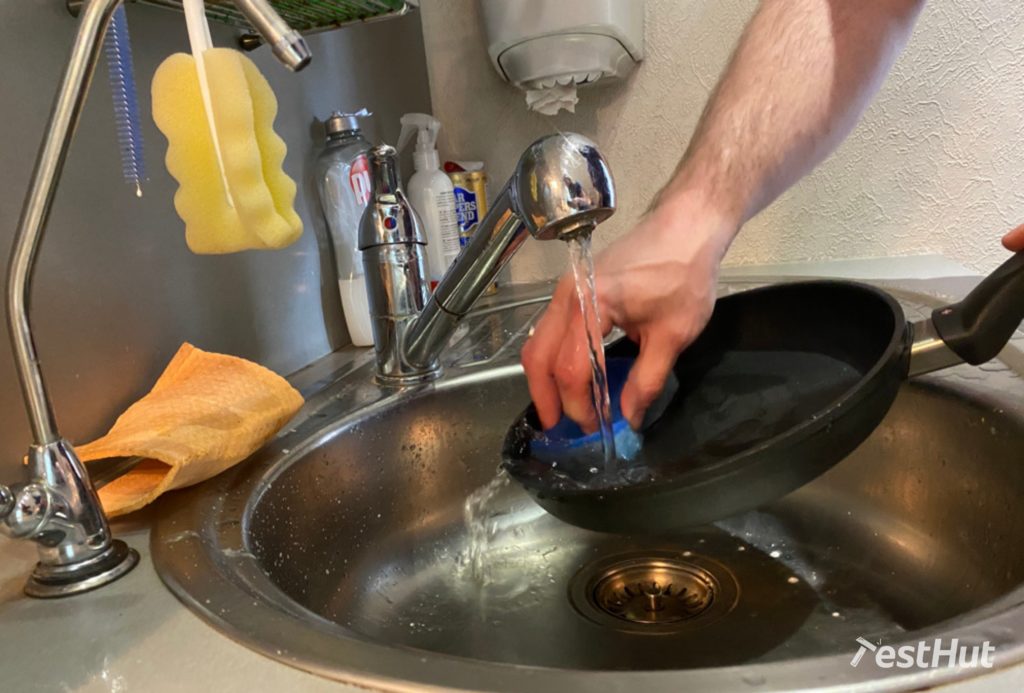
Cleaning and maintenance is about how easy it is to use the pan daily, but since this is something the user must face every time after a cooking session, we decided that this criterion is important enough to be a separate category. While the surfaces of all nonstick pans are extremely easy to clean, in most cases they needed only water and a gentle stroke with a sponge. We also took into account the shape of the handle, and whether it has hard-to-reach spots that could collect grime over time such as rivets.
Versatility
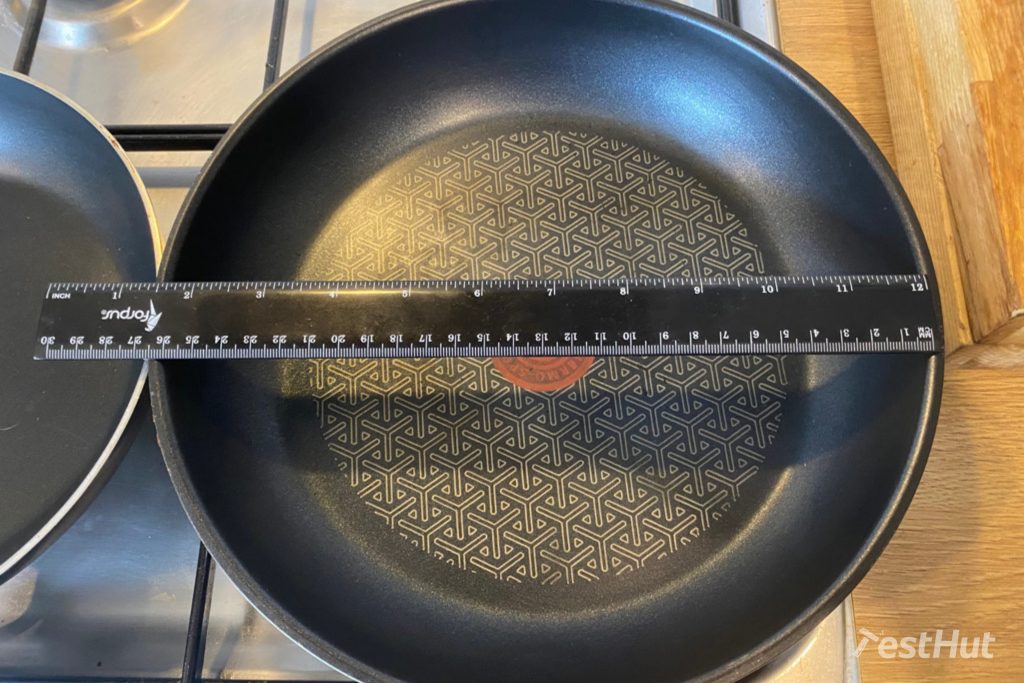
Since the shape of every frying pan is different, we measured how big the actual cooking surface was, not the overall size stated by the manufacturer. We added chicken legs and wings to see how much each pan could fit and how crowded the food was. This criterion is included in the Versatility category along with volume and other measurements. We measured the overall capacity of each pan by filling them with water, and then tested how easy it was to pour the liquid out. We tried both water and thicker tomato sauce. We looked at the pan temperature ratings to see if you can use it in the oven. We tried to flip pancakes, eggs, and cheese balls to see which pans are the easiest to manoeuvre.
Design
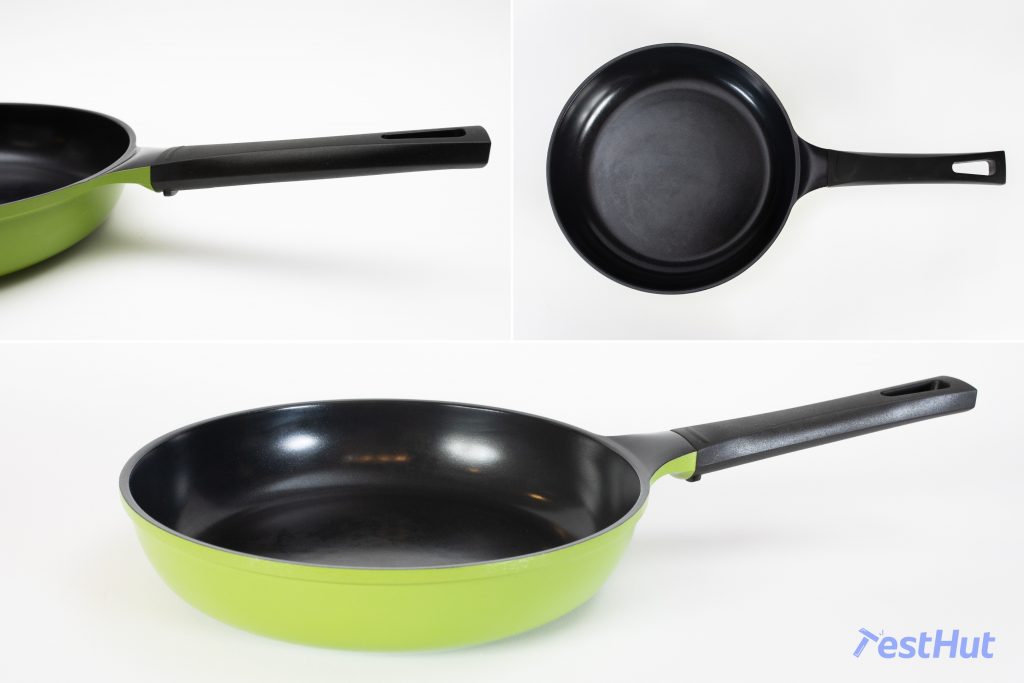
We also scored Design. Although aesthetics is very subjective, we tried to be objective about whether or not these pans could go on our dinner table with pride. And the last criterion was storage; we measured the footprint of each pan and tested them on various kitchen hooks. Not all of the pans fit on all kitchen hooks.
Nonstick frying pan overall scores table
| Frying pan | OVERALL SCORE (100%) | Cooking performance (40%) | Durability (20%) | Ease of use (15%) | Cleaning and maintenance (15%) | Versatility (5%) | Design (5%) |
|---|---|---|---|---|---|---|---|
| Circulon Infinite French Skillet 24 cm | 4.2 | 4.8 | 3.0 | 4.0 | 4.5 | 4.2 | 3.5 |
| Swiss Diamond XD Induction 24 cm | 4.2 | 4.9 | 3.0 | 4.3 | 4.5 | 3.9 | 3.9 |
| Ozeri GreenEarth Smooth Ceramic Pan 26 cm | 3.7 | 4.1 | 2.5 | 3.6 | 4.5 | 4.5 | 2.7 |
| Ikea Trovärdig Nonstick 24 cm | 3.7 | 3.9 | 2.5 | 3.6 | 4.5 | 3.9 | 3.9 |
| GreenPan Cambridge 24 cm | 3.7 | 4.2 | 2.0 | 4.4 | 4.0 | 3.4 | 3.3 |
| Scanpan Classic 24 cm | 3.6 | 3.9 | 2.5 | 3.7 | 4.5 | 3.4 | 3.3 |
| AmazonBasics 24 cm Frying Pan | 3.6 | 3.6 | 3.0 | 4.1 | 4.0 | 4.0 | 3.1 |
| Tefal Precision Plus 24 cm | 3.6 | 4.1 | 1.5 | 4.2 | 4.5 | 3.1 | 3.3 |
| Tefal Comfort Max 26 cm | 3.5 | 3.5 | 2.5 | 4.4 | 4.0 | 4.4 | 3.0 |
| Zyliss Cook Nonstick 24 cm | 3.4 | 4.1 | 1.0 | 4.1 | 4.5 | 3.3 | 2.9 |
| Ikea Kavalkad | 3.2 | 3.4 | 1.5 | 3.8 | 4.5 | 2.5 | 2.4 |
Table notes
Overall score: The final grade of each pan is a weighted average score. Pans that got higher grades than 3.5 are labelled as Recommended.
Only two pans scored below 3.5: the Zyliss Cook Nonstick, mostly because it didn’t survive our durability tests; and Ikea Kavalkad, which scored low in multiple categories and we concluded it is more of a breakfast pan than a daily driver for general cooking needs.
Cooking performance: The highest scores in this category went to the Swiss Diamond XD and Circulon Infinite—pans that delivered excellent cooking results with even heating and steady temperature. Our ceramic picks, GreenPan Cambridge and Ozeri GreenEarth, made good food, but they were not as excellent at even heating. Both had over 10°C difference between the centre of the pan and the sides.
The lowest scores went to Tefal Comfort Max and AmazonBasic nonsticks, both of which performed terribly in the temperature steadiness test. These pans need a learning curve to get used to high temperature climb and adjust the temperature right. In most of our tests, this resulted in poorly prepared food.
Durability: None of the nonstick pans could earn a higher score than 3 in the Durability category, since none of them are buy-for-life purchases. No matter how good the coating is, it will eventually wear down and you will have to replace your old nonstick with a new one. Further differences between grades depend on how durable the coating and the body of the pan are. For example, the Zyliss Cook Nonstick pan warped after the cold-water immersion test and it couldn’t handle the burnt rice test, which damaged the coating, and the pan lost its nonstick properties.
Ease of Use: Overall, all nonstick pans got high grades in this category. Those with lower scores mainly had issues with the handle’s comfort and safety. For example, the Ozeri GreenEarth ceramic pan has an extended cooking area, touching the handle and is almost as hot as the cooking surface.
Apart from that, nonstick pans have comfortable handles, they are lightweight and easy to lift, the nonstick coating helps with utensil access, and mostly they heat up quickly and then stabilize the temperature during cooking. Only two pans had problems with reaching too high temperatures during longer cooking sessions—Tefal Comfort Max and AmazonBasics nonstick.
Cleaning and maintenance: All nonstick pans required only a sponge and a few gentle strokes to clean them after a cooking session, but some took just a little bit more effort to clean the outside exterior with difficult shapes, angles, or rivets. For example, AmazonBasics nonstick pan has rivets inside and a stainless-steel exterior, which is generally harder to clean than Teflon.
Versatility: In this category high scores went to bigger and deeper pans since their cooking areas fit more food. For example, the Swiss Diamond XD nonstick has lower sidewalls, therefore it doesn’t fit as much food as Tefal Comfort Max.
Since anyone can always choose a larger size, this category has a low overall impact on the final score. Another criterion where some pans lost a few points was oven use, because Bakelite handles, like Tefal Precision Plus, have lower temperature limits than stainless steel handles, like Circulon infinite.
Design: Nonstick frying pans, in general, are not the most beautiful cookware type, some pans, like Swiss Diamond, Ikea Trovärdig, and Circulon express more quality and are more appealing than others, but overall, none of the pans got the highest score, simply because they are not table ready.
Additional points went to those pans that are easy to store, like Scanpan Classic and GreenPan Cambridge, which are pans with low sides, low handles, and they fit on all kitchen hooks.
Conclusion
After months of testing, we think that you can’t go wrong with a Circulon nonstick pan. Our premium choice, the Swiss Diamond XD, will give you years of life and terrific performance on any hob. If you are looking for a decent budget pan, then take a look at the Tefal Precision Plus series or the Ikea Trovärdig. However, if you want to avoid Teflon, we recommend getting an Ozeri. Overall, we are sure that any of our top picks will be frying up eggs with no mess, giving you great cooking results time and time again.
For a piece of more in-depth advice, read our main frying pan guide, which covers nonstick pans as well as other types, like stainless, cast iron, carbon steel, and copper.
Source
- American Cancer Society. (2020). Perfluorooctanoic Acid (PFOA), Teflon, and Related Chemicals.
